Special Report
The Drunkest (and Driest) Cities in America
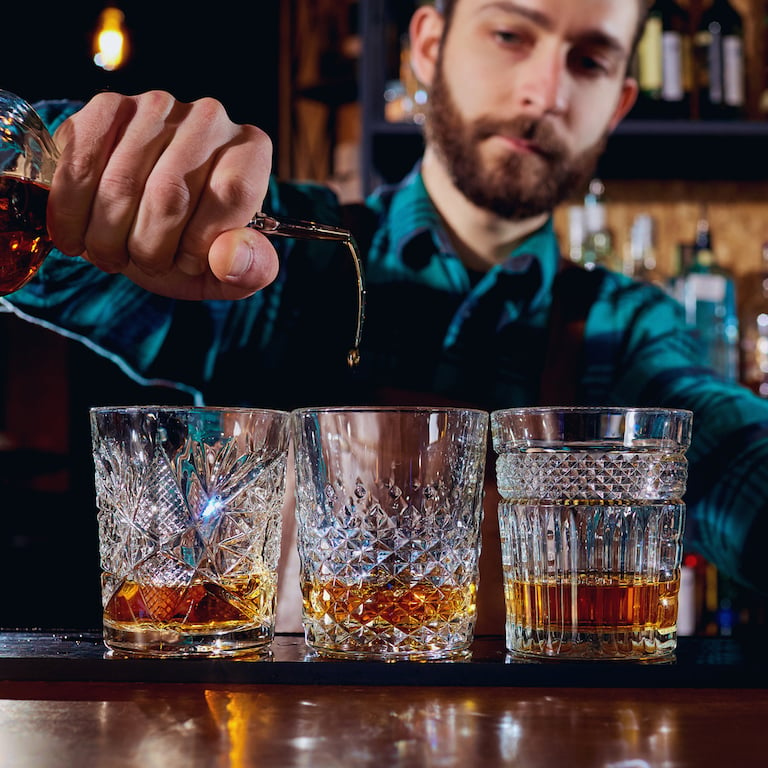
Published:
Last Updated:

Though alcohol is enjoyed responsibly by millions of Americans every day, it is also misused and abused by many — and over consumption can have serious consequences. According the Centers for Disease Control and Prevention, 18.0% of American adults regularly consume unhealthy amounts of alcohol. In some American cities, excessive drinking rates are higher.
Excessive drinking, according to the CDC, includes binge drinking — which is defined as four or more drinks on a single occasion for women and five or more for men — and heavy drinking, or eight or more drinks per week for women and 15 or more for men.
In the short term, excessive drinking can increase the likelihood of violence, risky sexual behavior, alcohol poisoning, and injuries. The potential long term effects of excessive alcohol consumption include depression, anxiety, alcohol dependence, and social problems. Long-term excessive drinking can also lead to chronic diseases, including certain cancers, liver disease, and heart disease.
24/7 Wall St. reviewed the adult excessive drinking rate in 381 U.S. metro areas to identify the 20 drunkest (and 20 driest) cities. The cities with the highest excessive drinking rates are concentrated in the Midwest, while those with the lowest rates are mostly in southern states.
Click here to see the drunkest cities in America.
Click here to see the driest cities in America.
Click here to see our detailed findings and methodology.
The Drunkest Cities in America
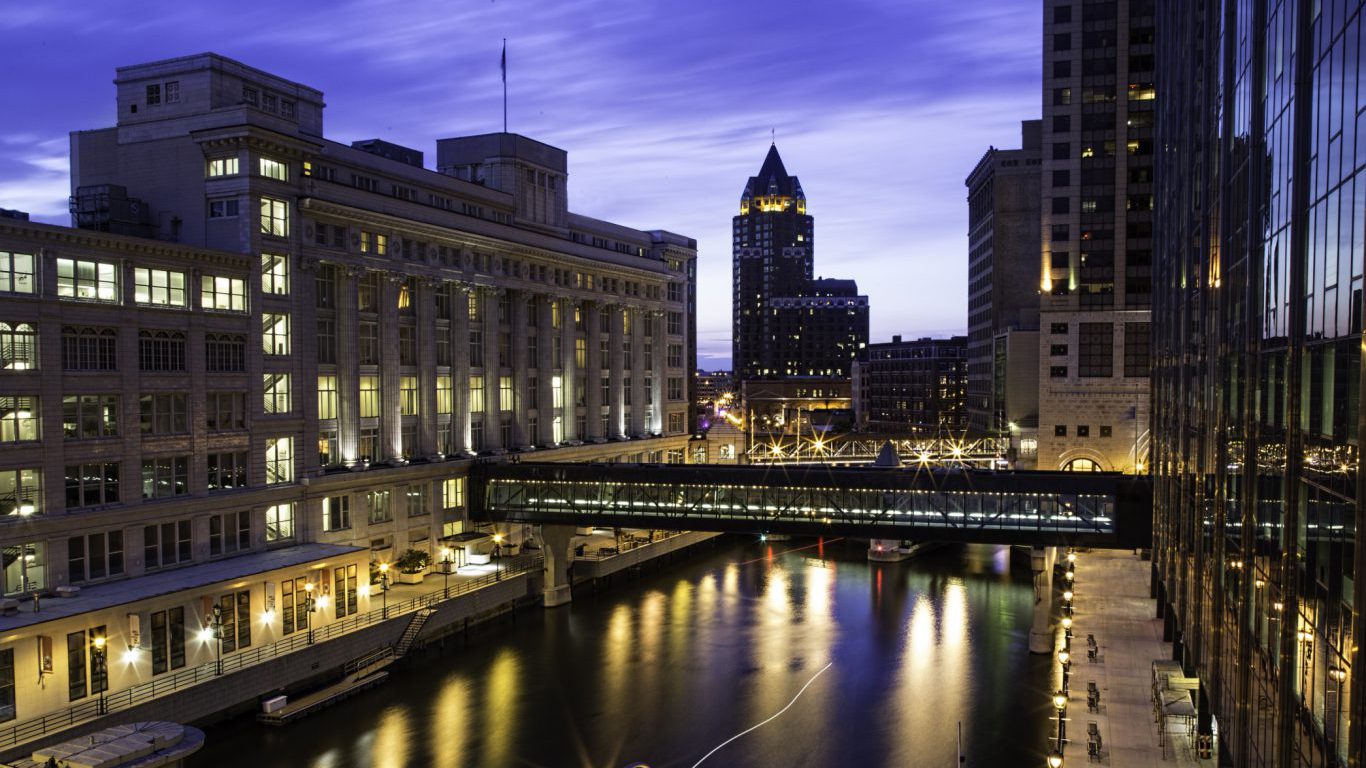
20. Milwaukee-Waukesha-West Allis, WI
> Pct. adults drinking to excess: 22.5%
> Pct. driving deaths involving alcohol: 36.4%
> Est. number of restaurants and bars: 2,921 (185.8 per 100,000)
> Median household income: $58,029
Some 22.5% of adults in the Milwaukee-Waukesha-West Allis metro area either binge or heavily drink, one of the highest excessive drinking rates of any metro area and well above the U.S. excessive drinking rate of 18.0%.
Excessive drinking rates in Wisconsin are higher outside of urban areas. Across Wisconsin, 26.2% of adults drink excessively, the largest share of any U.S. state. Of the 12 metro areas in the state, Green Bay is the only one with a higher excessive drinking rate than the state as a whole.
[in-text-ad]

19. Ames, IA
> Pct. adults drinking to excess: 22.7%
> Pct. driving deaths involving alcohol: 15.0%
> Est. number of restaurants and bars: 176 (181.3 per 100,000)
> Median household income: $53,371
Binge drinking is relatively common among college age students, and Ames, Iowa, has the highest concentration of college students of any U.S. city. Some 32.6% of Ames residents are enrolled in college, more than four times the national average. The fall 2017 enrollment for Iowa State University in Ames was over 36,000.
Some 22.7% of adults in the city report drinking excessively in the last month. A high excessive drinking rate does not necessarily mean drunk driving is also common. There were 3.6 alcohol related driving deaths for every 100,000 driving age residents in Ames between 2011 and 2015, the lowest rate of any metro area in the country.
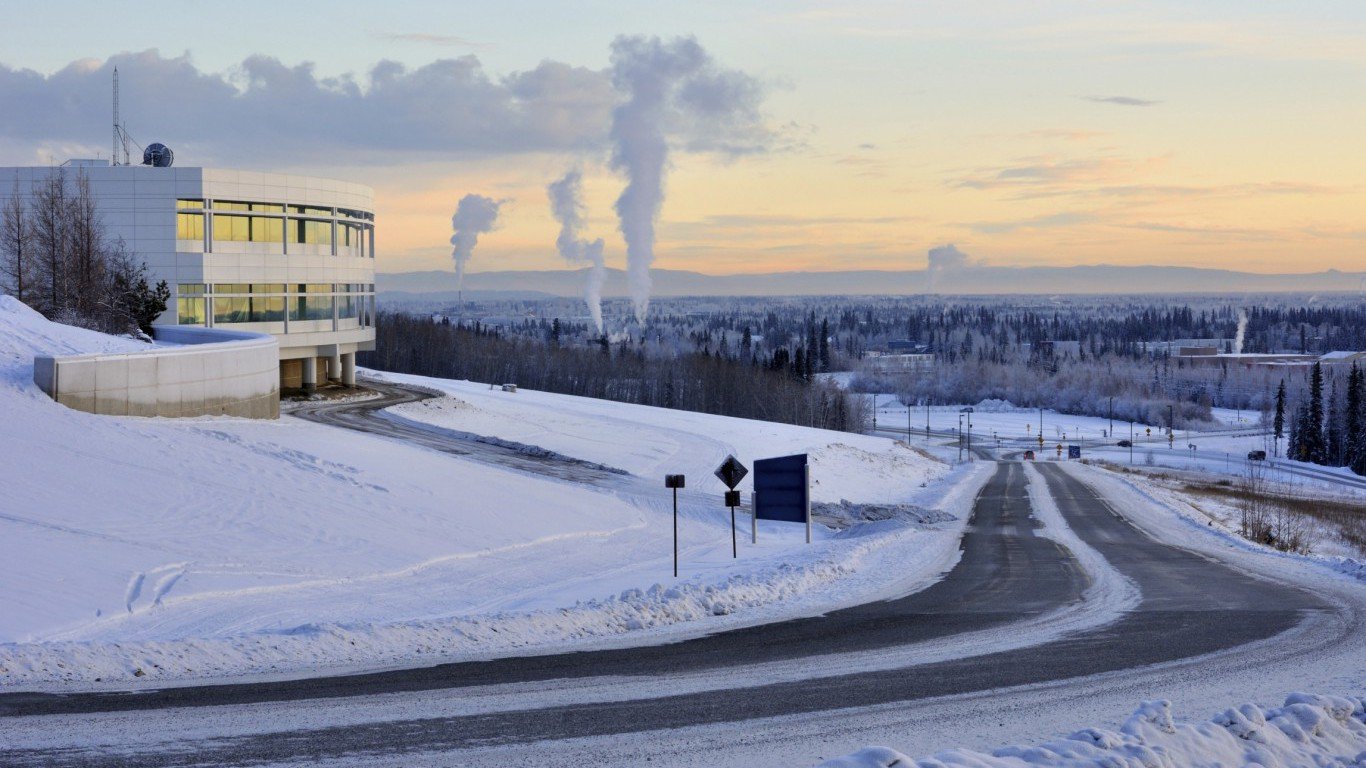
18. Fairbanks, AK
> Pct. adults drinking to excess: 22.7%
> Pct. driving deaths involving alcohol: 37.8%
> Est. number of restaurants and bars: 164 (163.0 per 100,000)
> Median household income: $77,328
Of Alaska’s two metro areas, Fairbanks and Anchorage, Fairbanks has the higher excessive drinking rate. Still, the excessive drinking rate in both Fairbanks, at 22.7%, and Anchorage, at 22.2%, far exceed the 19.1% rate across the state as a whole.
Excessive drinking is not the only unhealthy habit that is more common in Fairbanks than in Anchorage. Adults in Fairbanks are also less likely to exercise and more likely to smoke than residents in Alaska’s only other metro area.

17. Lincoln, NE
> Pct. adults drinking to excess: 22.7%
> Pct. driving deaths involving alcohol: 25.5%
> Est. number of restaurants and bars: 668 (204.5 per 100,000)
> Median household income: $59,344
The University of Nebraska in Lincoln has more than 26,000 students on its campus, and many of them are likely contributing to the area’s high excessive alcohol consumption rate. A National Institutes of Health study found that 60% of college students report drinking at least once in the last month, and 40% of students report binge drinking.
Lincoln is the only metro area in Nebraska on this list, even though adults in the state are some of the most likely to drink excessively. Some 21.1% of adults in Nebraska reported drinking to excess, the fifth highest rate among states.
[in-text-ad-2]
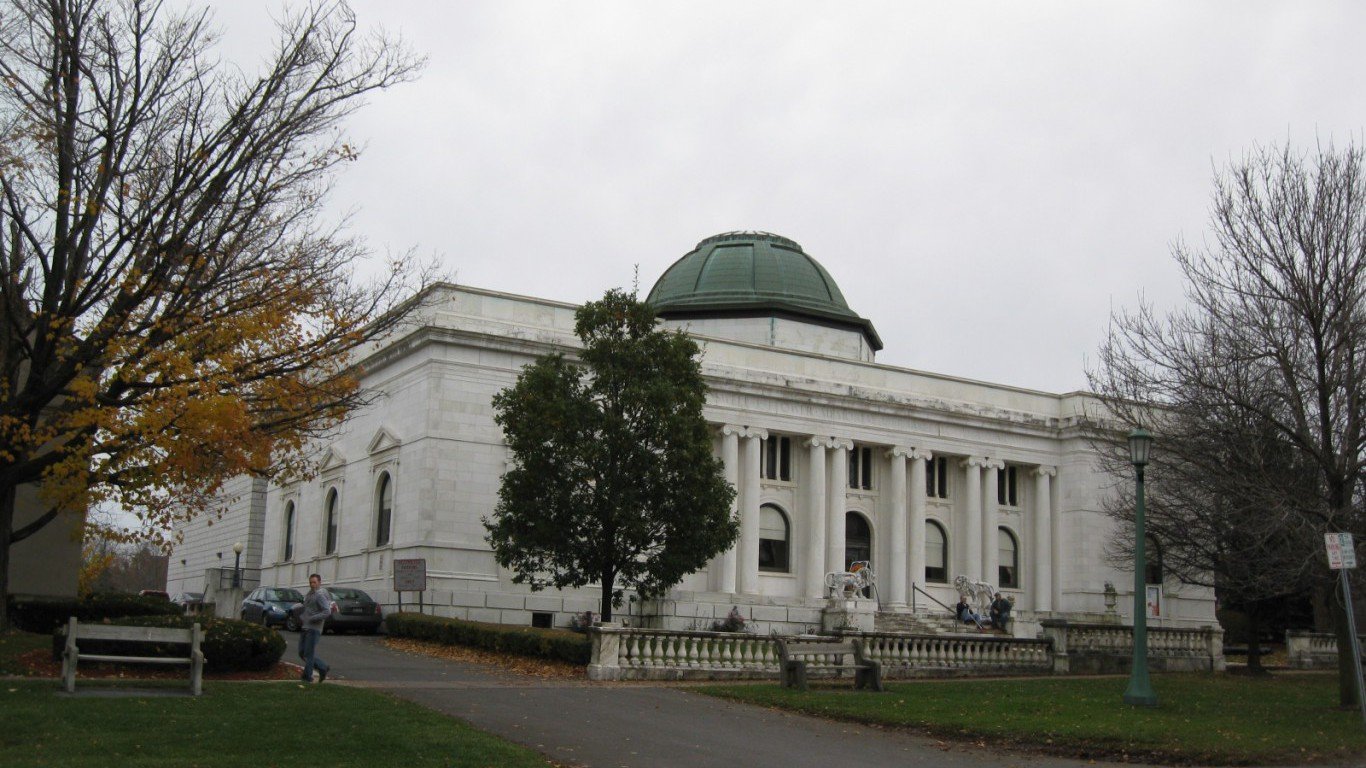
16. Watertown-Fort Drum, NY
> Pct. adults drinking to excess: 22.9%
> Pct. driving deaths involving alcohol: 32.8%
> Est. number of restaurants and bars: 270 (236.8 per 100,000)
> Median household income: $45,624
New York state’s 18.8% excessive drinking rate is similar to the nationwide excessive drinking rate of 18.0%. New York is one the most populous states in the country, and not all communities report similar alcohol consumption habits. In the Watertown-Fort Drum metro area, 22.9% of adults either binge or heavily drink, a larger share than in any of the state’s 11 other metro areas and the 16th largest rate of any metro area in the country.
Metro areas with high excessive drinking rates are often wealthier than areas with healthier drinking habits. Watertown-Fort Drum is an exception. The typical area household earns $45,624 a year, the lowest median income of any metro area in the state and well below the U.S. annual median of $57,617.
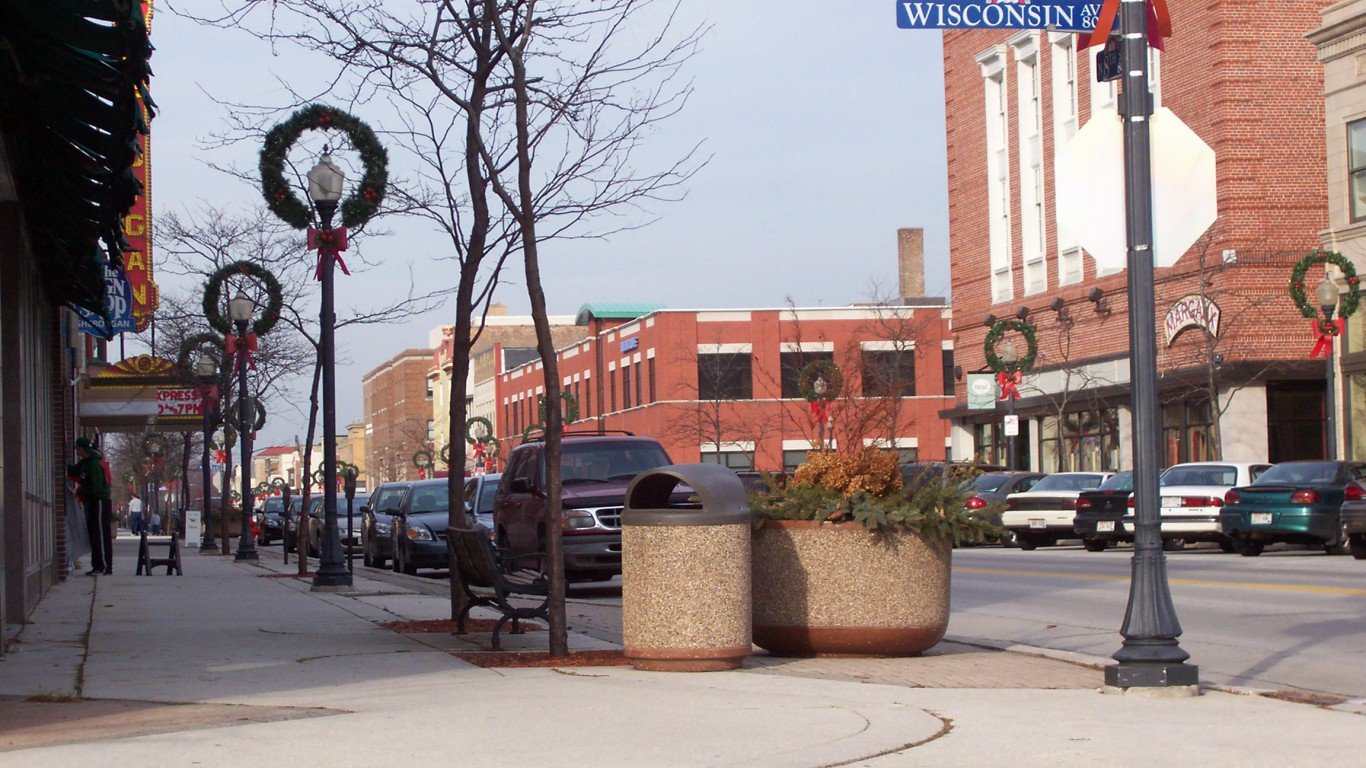
15. Sheboygan, WI
> Pct. adults drinking to excess: 23.0%
> Pct. driving deaths involving alcohol: 27.1%
> Est. number of restaurants and bars: 234 (202.7 per 100,000)
> Median household income: $54,059
Alcohol is expensive and often only affordable to those with disposable income — and very few people in Sheboygan struggle for money. The area’s poverty rate of just 5.4% is the lowest in the nation by more than a full percentage point and well below the 14.0% national poverty rate.
Wisconsin is the heaviest drinking state in the country and Sheboygan is one of 10 metro areas in the state to rank among the heaviest drinking in the country. Some 23.0% of adults in the Sheboygan metro area drink excessively.
[in-text-ad]
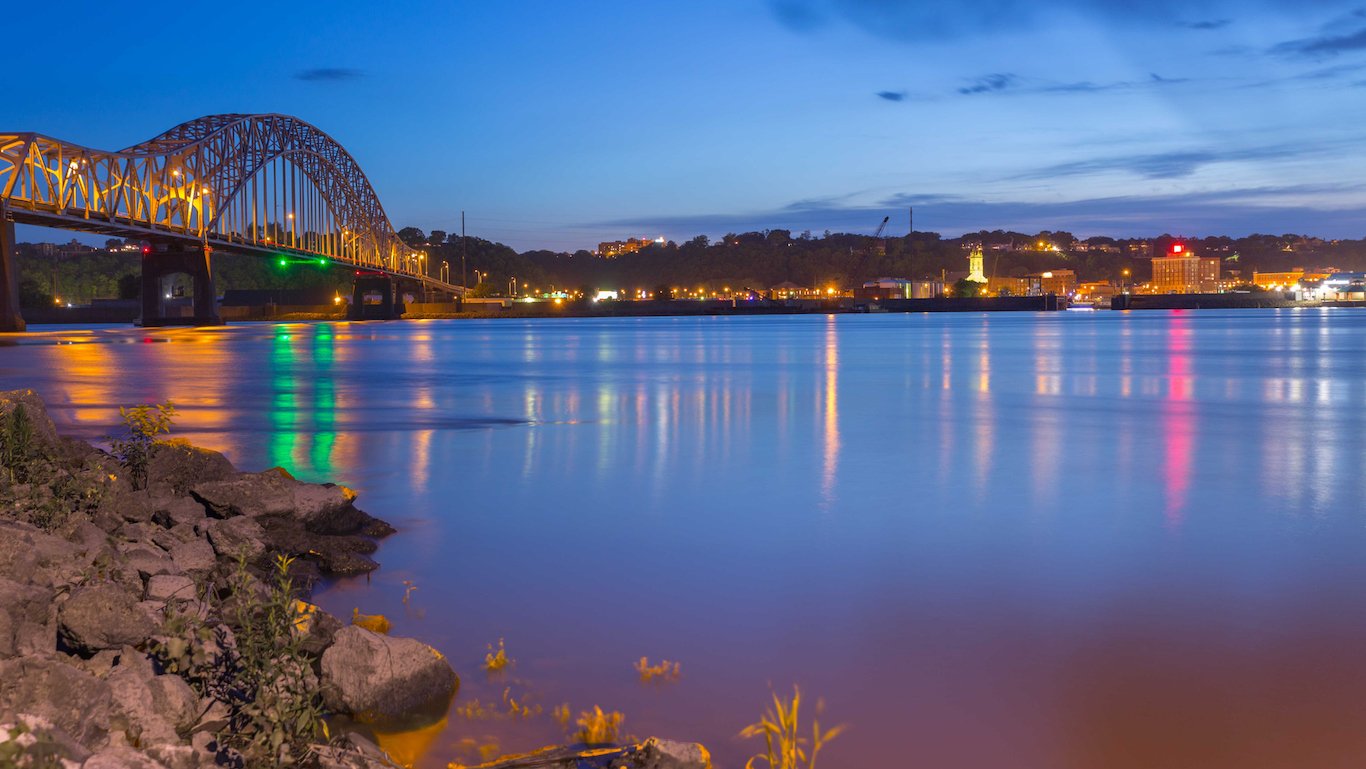
14. Dubuque, IA
> Pct. adults drinking to excess: 23.0%
> Pct. driving deaths involving alcohol: 40.0%
> Est. number of restaurants and bars: 199 (205.1 per 100,000)
> Median household income: $60,456
Dubuque is one of three metro areas in Iowa to rank among those with the highest excessive drinking rates nationwide. Some 23.0% of adults in the Dubuque metro area drink excessively, compared to 22.1% of adults across the state and 18.0% of adults nationwide.
Excessive drinking is a risky behavior, and getting behind the wheel after drinking also endangers the lives of others. In Dubuque, a larger than typical 40% share of driving deaths involve alcohol. Nationwide, 30% of driving deaths involve alcohol.

13. Iowa City, IA
> Pct. adults drinking to excess: 23.1%
> Pct. driving deaths involving alcohol: 17.7%
> Est. number of restaurants and bars: 387 (229.2 per 100,000)
> Median household income: $57,777
Like many college towns, the Iowa City metro area boasts a high concentration of bars and restaurants. There are an estimated 387 places to drink in the area, or about 229 per 100,000 people. That is well above the national average concentration of 184 places to drink per 100,000 people.
The high concentration of drinking venues may be partially explained by demand. In Iowa City, 23.1% of adults report drinking excessively, a larger share than in all but a dozen other U.S. metro areas and slightly higher than the statewide excessive drinking rate of 22.1%.

12. Fond du Lac, WI
> Pct. adults drinking to excess: 23.5%
> Pct. driving deaths involving alcohol: 27.0%
> Est. number of restaurants and bars: 188 (184.1 per 100,000)
> Median household income: $58,310
Fond du Lac is one of 10 Wisconsin metro areas to appear on this list. Though 23.5% of adults in the metro area drink excessively, they are actually less likely than the average Wisconsin adult to drink excessively. In Wisconsin, 26.2% of adults drink excessively — the highest rate of any state and well above the 18.0% national average.
Excessive drinking is never healthy. Still, alcohol consumption is just one of a multitude of factors that can affect health outcomes across a population. Despite the metro area’s relatively high excessive drinking rate, just 13.8% of adults in Fond du Lac are in fair or poor health, well below the 16.0% of adults nationwide.
[in-text-ad-2]
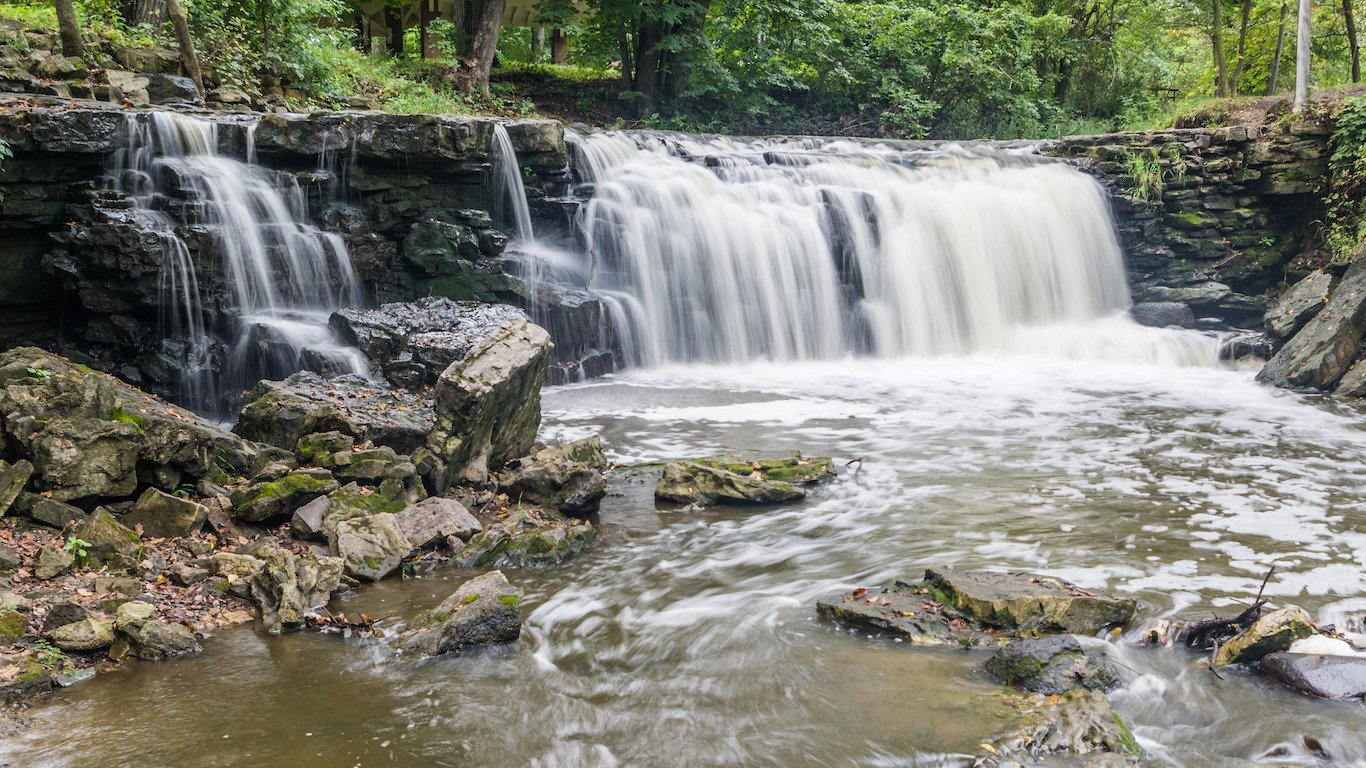
11. Mankato-North Mankato, MN
> Pct. adults drinking to excess: 23.6%
> Pct. driving deaths involving alcohol: 18.0%
> Est. number of restaurants and bars: 181 (181.0 per 100,000)
> Median household income: $57,833
Mankato-North Mankato is the only metro area in Minnesota to rank among the cities with the highest excessive drinking rates. Some 23.6% of adults in Mankato-North Mankato drink excessively, a larger share than the 22.9% of adults across the state and the 22.3% of adults who drink excessively in Duluth, the second heaviest drinking metro area in Minnesota.
While excessive drinking is relatively common in the metro area, drunk driving does not appear to be. From 2011 to 2015, there were 50 driving deaths in the Mankato-North Mankato metro area, only nine of which involved alcohol. The area’s rate of 10.9 alcohol involved driving deaths per 100,000 driving age residents is one of the lowest rates in the nation.
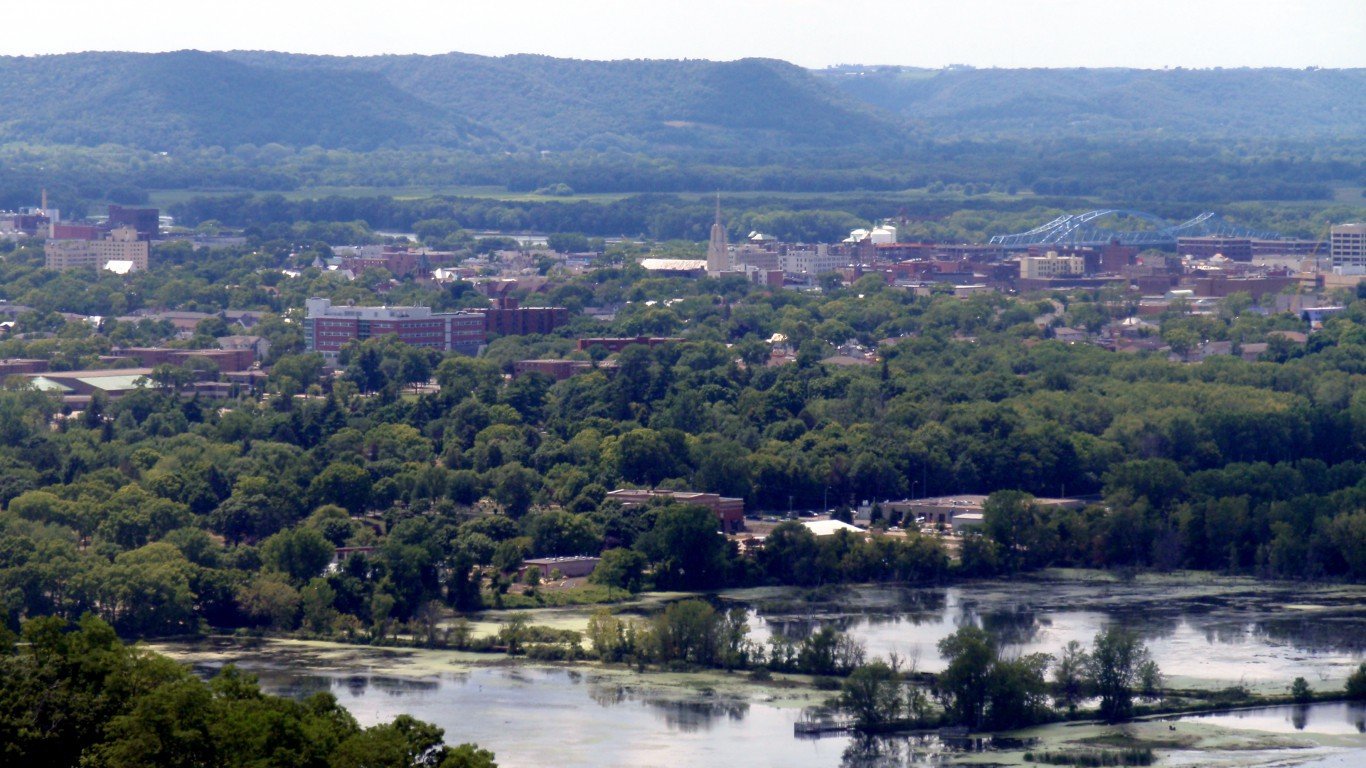
10. La Crosse-Onalaska, WI-MN
> Pct. adults drinking to excess: 23.8%
> Pct. driving deaths involving alcohol: 26.4%
> Est. number of restaurants and bars: 313 (228.6 per 100,000)
> Median household income: $55,717
Bars and restaurants are more common in La Crosse-Onalaska, Wisconsin than in the majority of U.S. metro areas. The are 313 drinking venues in the area of just under 137,000 people, which amounts to about 229 bars and restaurants per 100,000 people. Nationwide, there are just 184 bars and restaurants for every 100,000 people.
Serious car accidents can be the result of a number of factors and conditions and a high excessive drinking rate does not necessarily mean metro area residents are more likely to drive under the influence. In La Crosse, driving deaths are actually less likely to involve alcohol than is typical nationwide. Alcohol is a factor in 26.4% of fatal auto accidents in the metro area compared to 30.0% nationwide.
[in-text-ad]
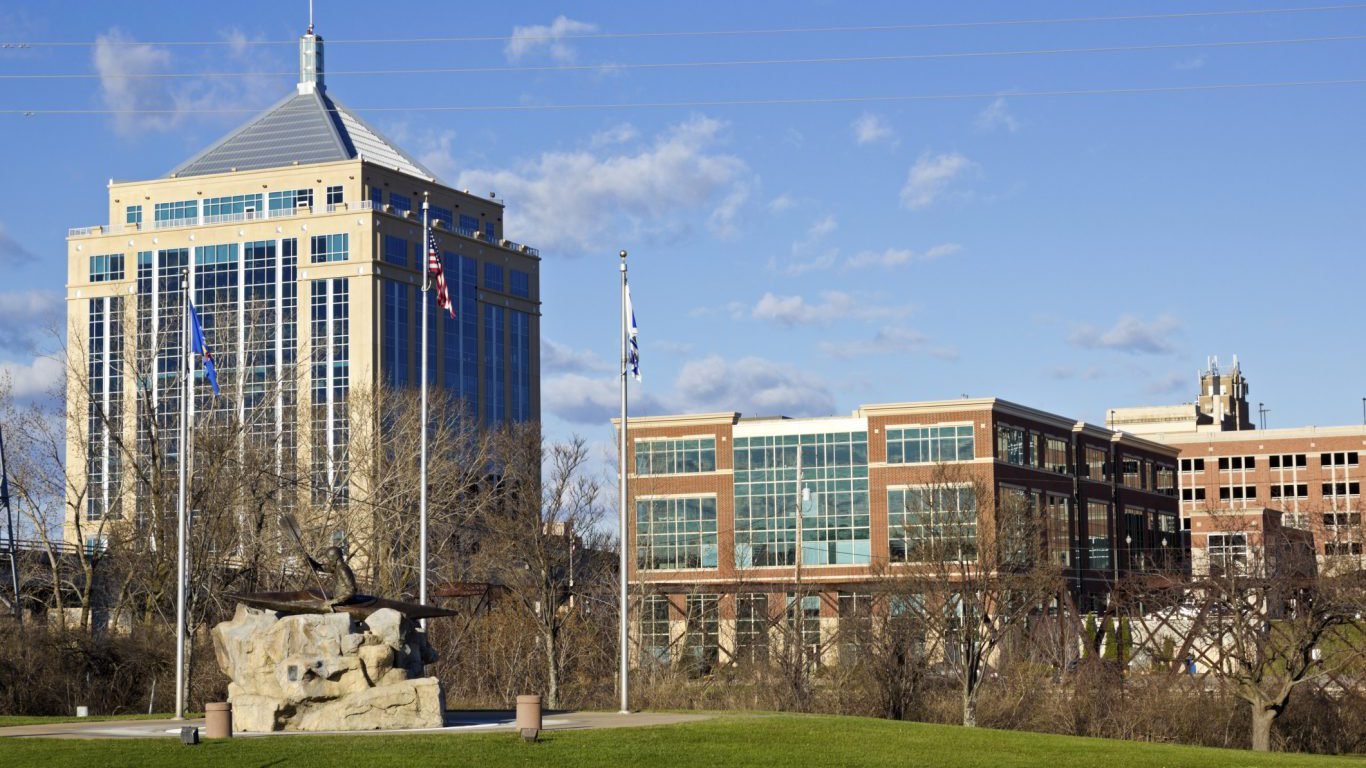
9. Wausau, WI
> Pct. adults drinking to excess: 24.2%
> Pct. driving deaths involving alcohol: 28.9%
> Est. number of restaurants and bars: 253 (186.6 per 100,000)
> Median household income: $54,774
Of the 10 metro areas with the highest excessive drinking rates, seven are in Wisconsin. The central Wisconsin metro area of Wausau is one of them. Some 24.2% of adults in the Wausau metro area drink excessively compared to 18.0% of American adults.
Though many Wisconsin metro areas are among those with the highest excessive drinking rates nationwide, the statewide excessive drinking rate of 26.2% is even higher than in most of its metro areas. Of the dozen metro areas in the state, Green Bay is the only one reporting a higher excessive drinking rate than the statewide rate. This means that excessive drinking is even more common outside of the state’s urban areas.
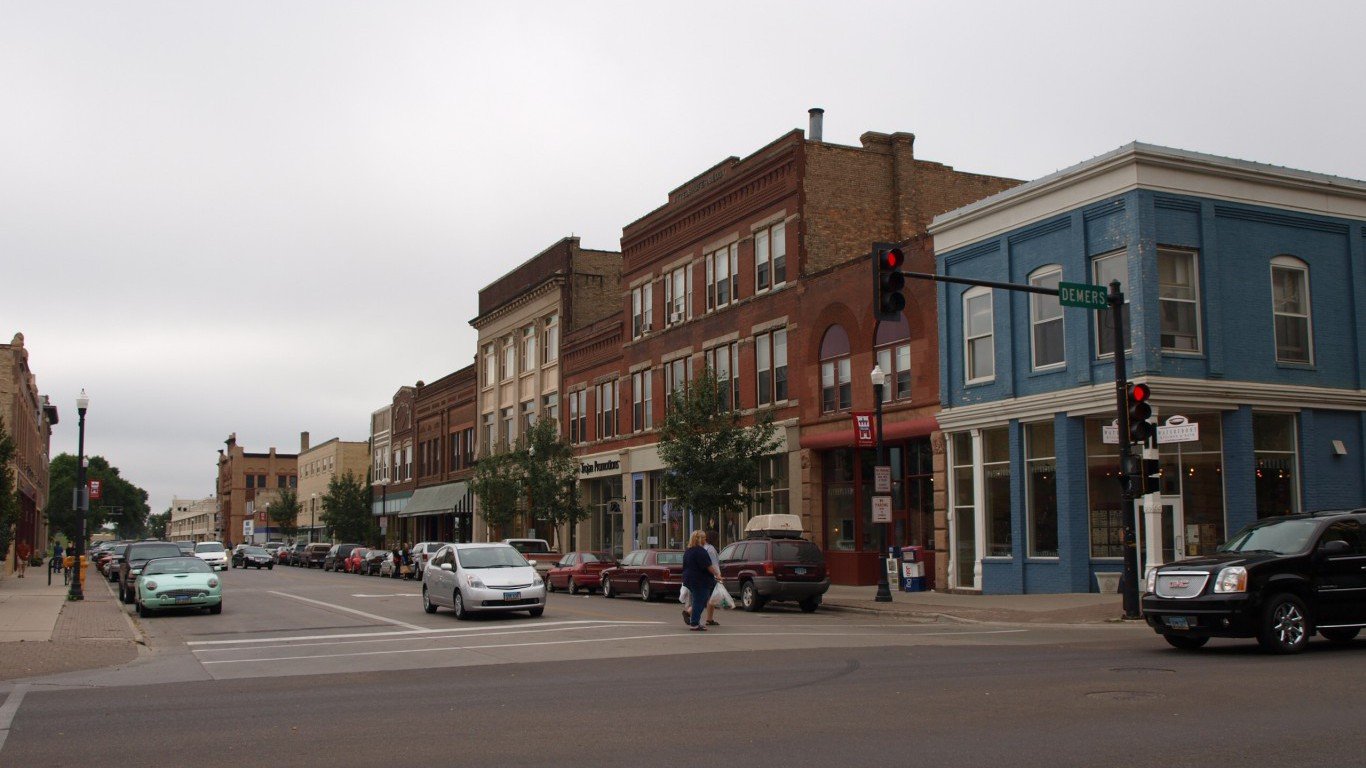
8. Grand Forks, ND-MN
> Pct. adults drinking to excess: 24.2%
> Pct. driving deaths involving alcohol: 34.0%
> Est. number of restaurants and bars: 206 (200.5 per 100,000)
> Median household income: $48,671
Because drinking alcohol can be expensive, places with high excessive drinking rates also often have high median incomes. But not in Grand Forks, North Dakota. The area’s median household income of $48,671 a year is well below the national median of $57,617.
The high excessive drinking rate may be at least partially explained by the presence of University of North Dakota. According to studies, university students tend to binge drink at far higher rates than other age groups. Grand Forks is one of several college towns to rank among the heaviest drinking metro areas.

7. Missoula, MT
> Pct. adults drinking to excess: 24.3%
> Pct. driving deaths involving alcohol: 44.4%
> Est. number of restaurants and bars: 285 (245.4 per 100,000)
> Median household income: $46,550
Missoula is the only metro area in Montana with a near nationleading excessive drinking rate. Some 24.3% of metro area adults drink excessively. This may be at least in part due to the fact that Missoula is home to the University of Montana and college students are among the most likely groups to drink to excess. The metro area in Montana with the second highest excessive drinking rate is Billings, where 22.0% of adults report drinking excessively.
Other than the greater tendency to drink excessively, adults in Missoula tend to make healthy lifestyle choices. A relatively low percentage are overweight, and a far greater than typical share get at least some exercise.
[in-text-ad-2]
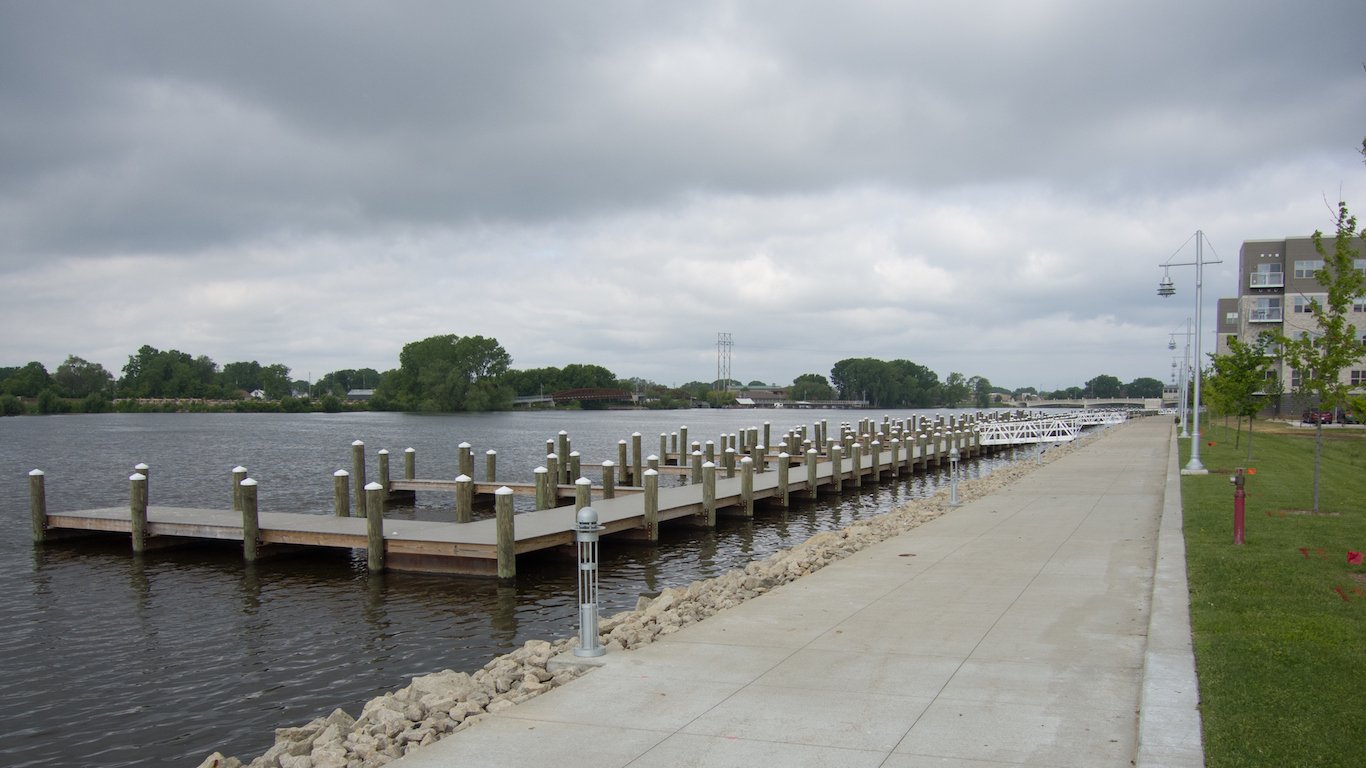
6. Oshkosh-Neenah, WI
> Pct. adults drinking to excess: 24.5%
> Pct. driving deaths involving alcohol: 47.9%
> Est. number of restaurants and bars: 327 (192.5 per 100,000)
> Median household income: $56,754
Some 24.5% of adults in the Oshkosh-Neenah, Wisconsin, metro area drink excessively, a far greater share than the 18.0% of adults nationwide. However, not all unhealthy behaviors are widespread in Oshkosh-Neenah. For example, just 16.4% of metro area adults smoke, below both the state smoking rate of 17.1% and the nationwide rate of 17.0%.
Wisconsin has the highest excessive drinking rate of any state in the country. Oshkosh-Neenah has the sixth highest excessive drinking rate in the country and the fifth highest in Wisconsin.
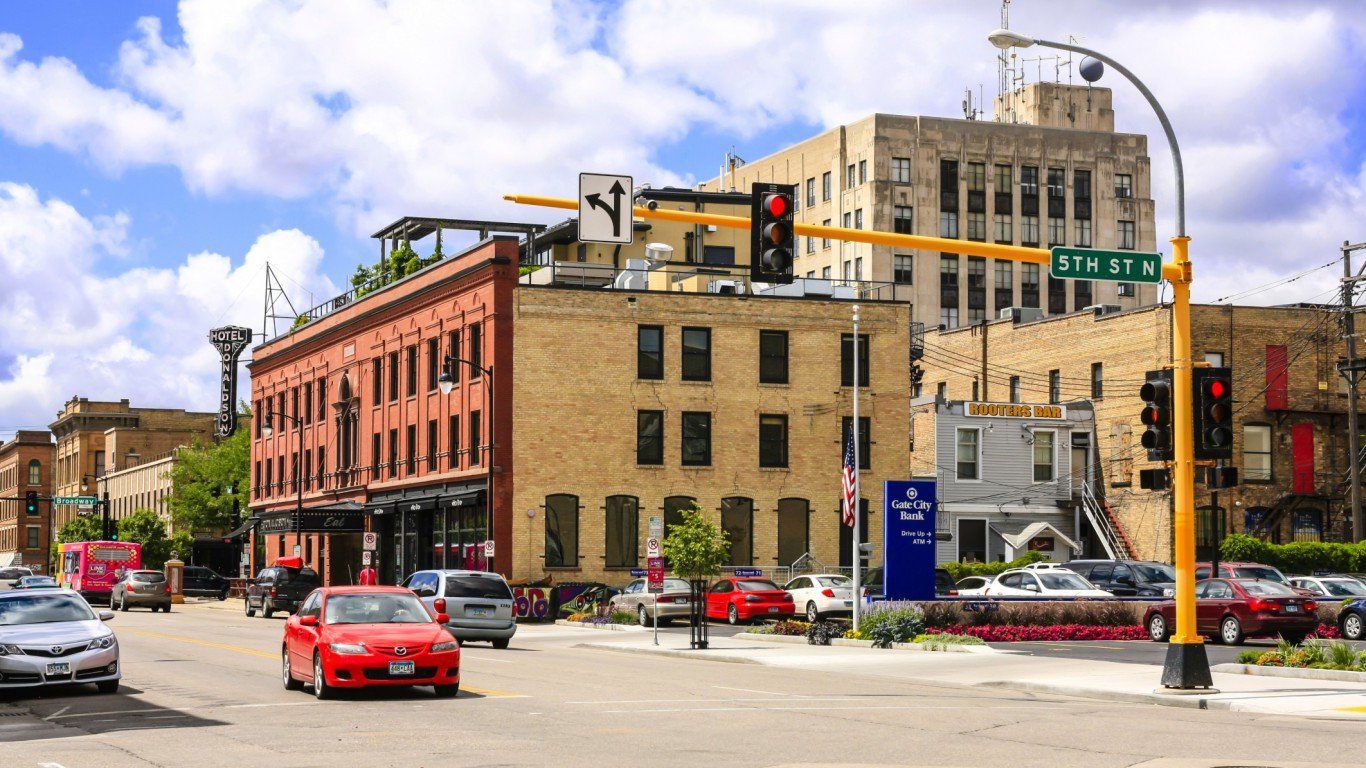
5. Fargo, ND-MN
> Pct. adults drinking to excess: 25.2%
> Pct. driving deaths involving alcohol: 38.0%
> Est. number of restaurants and bars: 433 (181.8 per 100,000)
> Median household income: $60,009
Slightly more than one in every four adults in Fargo, North Dakota drink excessively, the fifth largest share of any U.S. metro area. Still, excessive drinking is more common across North Dakota as a whole than in Fargo. At 25.9%, North Dakota’s excessive drinking rate is the second highest of all states, trailing only Wisconsin.
Driving is dangerous and serious car accidents can be the result of any number of factors. In Fargo, drunk driving is a common culprit. Some 38.0% of driving deaths in the metro area involve alcohol, more than the comparable 30.0% share nationwide.
[in-text-ad]
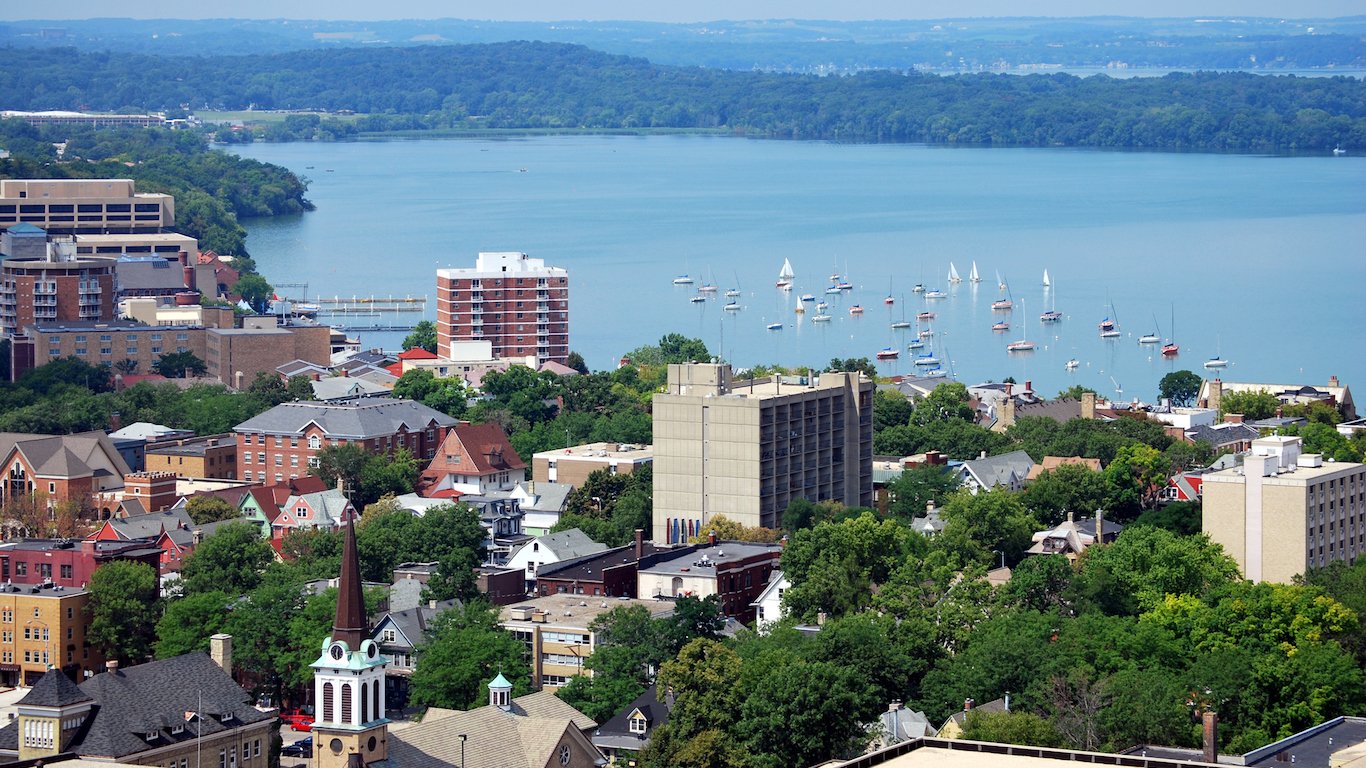
4. Madison, WI
> Pct. adults drinking to excess: 25.9%
> Pct. driving deaths involving alcohol: 38.0%
> Est. number of restaurants and bars: 1,464 (225.6 per 100,000)
> Median household income: $68,497
All four U.S. metro areas with the highest excessive drinking rates are in Wisconsin, and Madison is fourth. Some 25.9% of adults in the metro area report drinking excessively compared to 18.0% of adults nationwide.There are about 226 bars and restaurants for every 100,000 Madison metro area residents. Nationwide, there are 184 drinking establishments per 100,000 people.
Nearly 44,000 students attend the University of Wisconsin in Madison. College students often report high levels of binge drinking, likely contributing to the city’s overall excessive drinking rate.
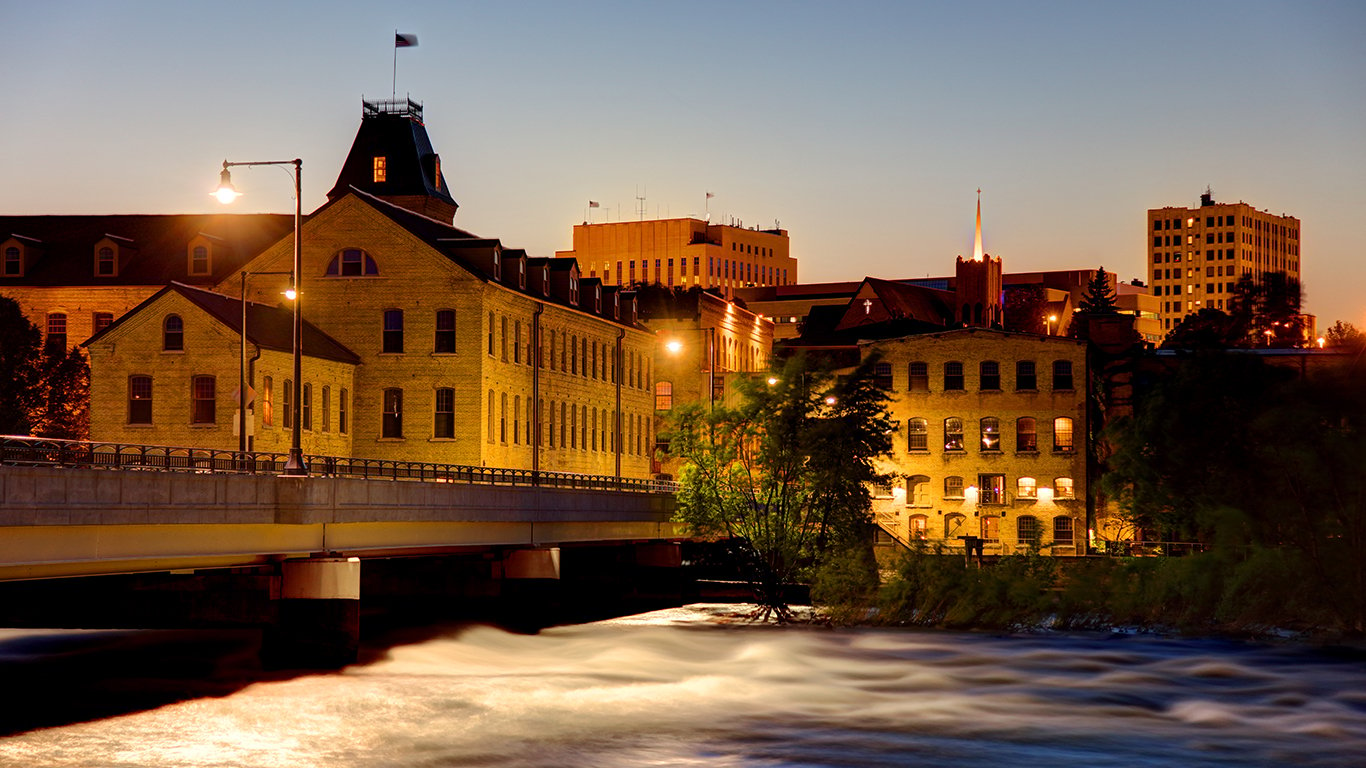
3. Appleton, WI
> Pct. adults drinking to excess: 26.2%
> Pct. driving deaths involving alcohol: 25.7%
> Est. number of restaurants and bars: 499 (213.2 per 100,000)
> Median household income: $63,902
Alcohol is a luxury good, and higher income areas often have relatively high excessive drinking rates. The median household income in Appleton is $63,902 a year, more than 10% higher than the national median household income. Appleton, Wisconsin is one of only five metro areas nationwide where more than one in every four adults drink excessively.
In Appleton, there is no shortage of options when it comes to drinking venues. There are 213 restaurants and bars for every 100,000 metro area residents, compared to the 184 per 100,000 national concentration.
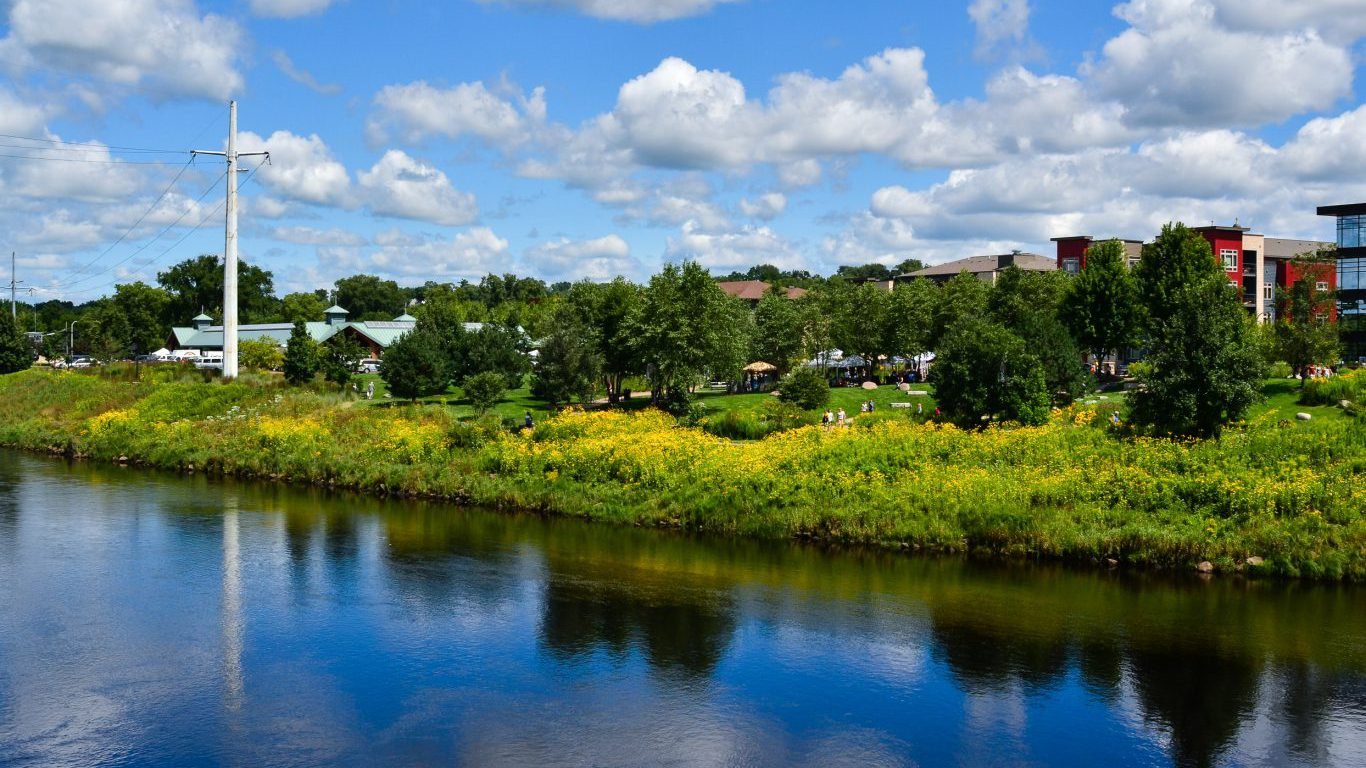
2. Eau Claire, WI
> Pct. adults drinking to excess: 26.2%
> Pct. driving deaths involving alcohol: 38.9%
> Est. number of restaurants and bars: 387 (232.3 per 100,000)
> Median household income: $51,058
Some 26.2% of adults in the Eau Claire metro area drink excessively, the second largest share among metro areas. It is easier to find a place to drink in Eau Claire, Wisconsin, than in much of the rest of the country. There are 232 bars and restaurants for every 100,000 residents, compared to the 184 per 100,000 concentration nationwide.
Driving is dangerous and deadly accidents can be the result of any number of factors and circumstances. But in Eau Claire, alcohol is a common culprit. Alcohol was involved in 38.9% of deadly car accidents, one of the highest percentages of any metro area and significantly higher than the 30.0% national average.
[in-text-ad-2]
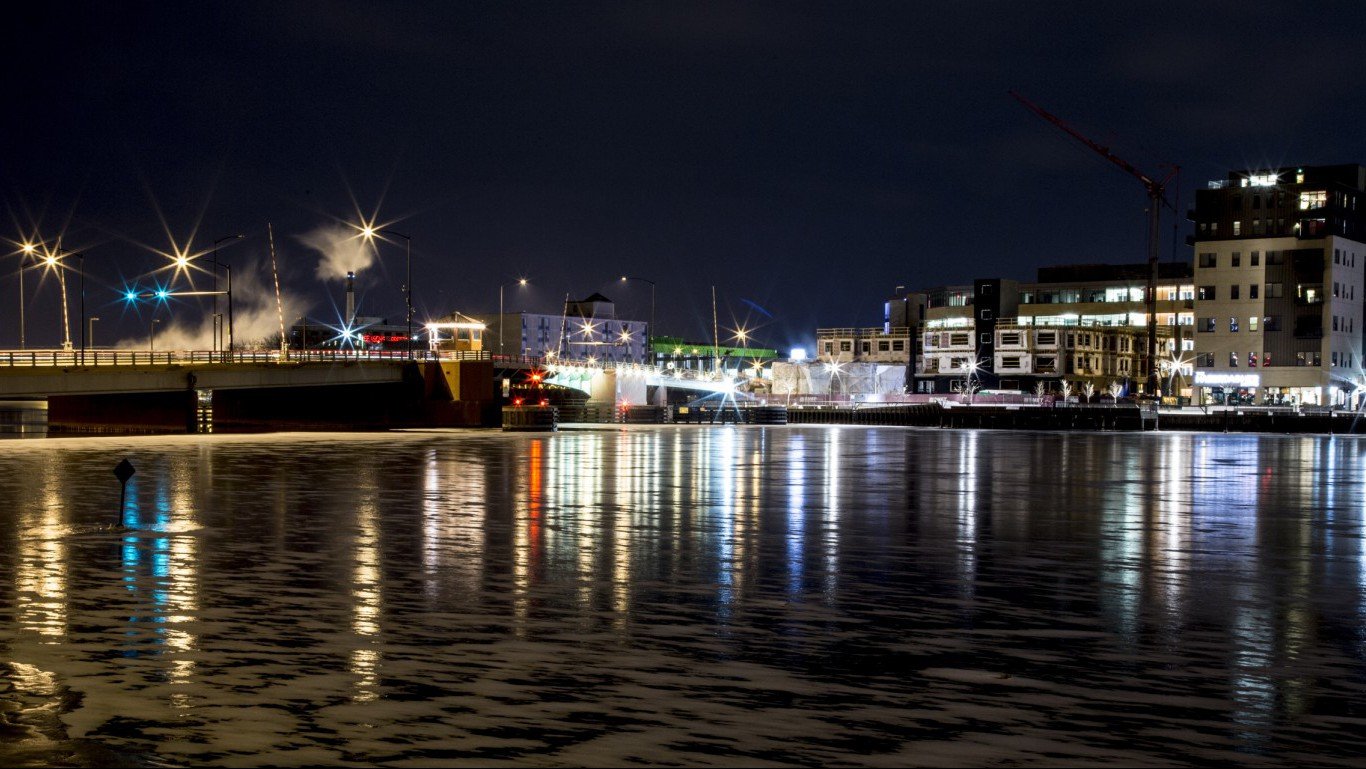
1. Green Bay, WI
> Pct. adults drinking to excess: 26.5%
> Pct. driving deaths involving alcohol: 50.5%
> Est. number of restaurants and bars: 652 (204.9 per 100,000)
> Median household income: $58,011
The heaviest drinking metro area in the heaviest drinking state, Green Bay, Wisconsin has the highest excessive drinking rate of any U.S. metro area. Some 26.5% of adults in Green Bay drink excessively, making it the only metro area in Wisconsin with a higher excessive drinking rate than the statewide average of 26.2%. For comparison, 18.0% of American adults drink excessively.
A high excessive drinking rate does not necessarily increase the likelihood of alcohol related car accidents. However, the Green Bay metro area is one of only five nationwide where alcohol was a factor in over half of all driving deaths.
The Driest Cities in America
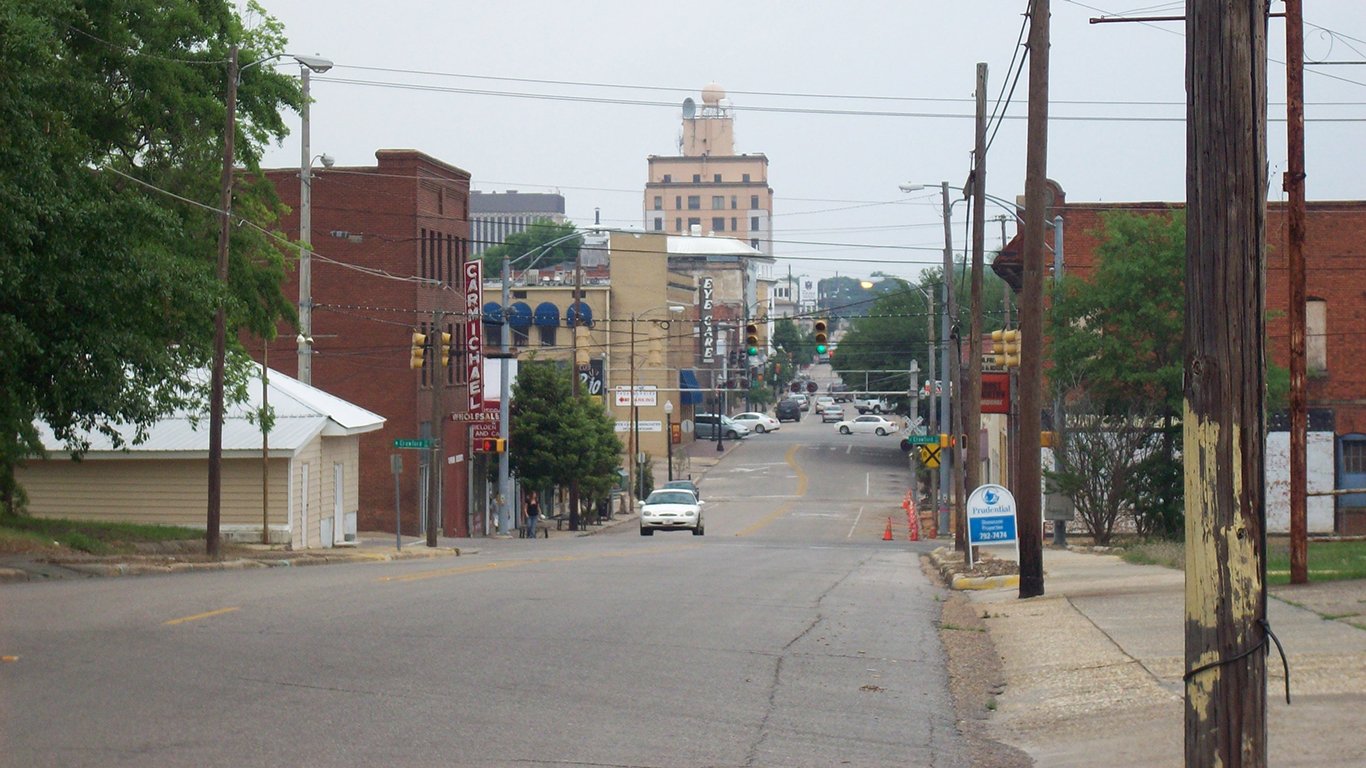
20. Dothan, AL
> Pct. adults drinking to excess: 13.0%
> Pct. driving deaths involving alcohol: 21.6%
> Est. number of restaurants and bars: 269 (182.0 per 100,000)
> Median household income: $41,040
Relatively few Dothan, Alabama, adults drink excessively. Some 13.0% of adults in the metro area report excessive drinking, or 5.0 percentage points lower than the national excessive drinking rate of 18.0%.
College students ages 18-22 are more likely than the adult population as a whole to binge drink. Typically, metro areas with large colleges tend to have have high excessive drinking rates, and areas with few college students tend to have have low excessive drinking rates. Just 4.3% of the population in the Dothan metro area is enrolled in graduate or undergraduate classes, one of the lower rates in the country.
[in-text-ad]
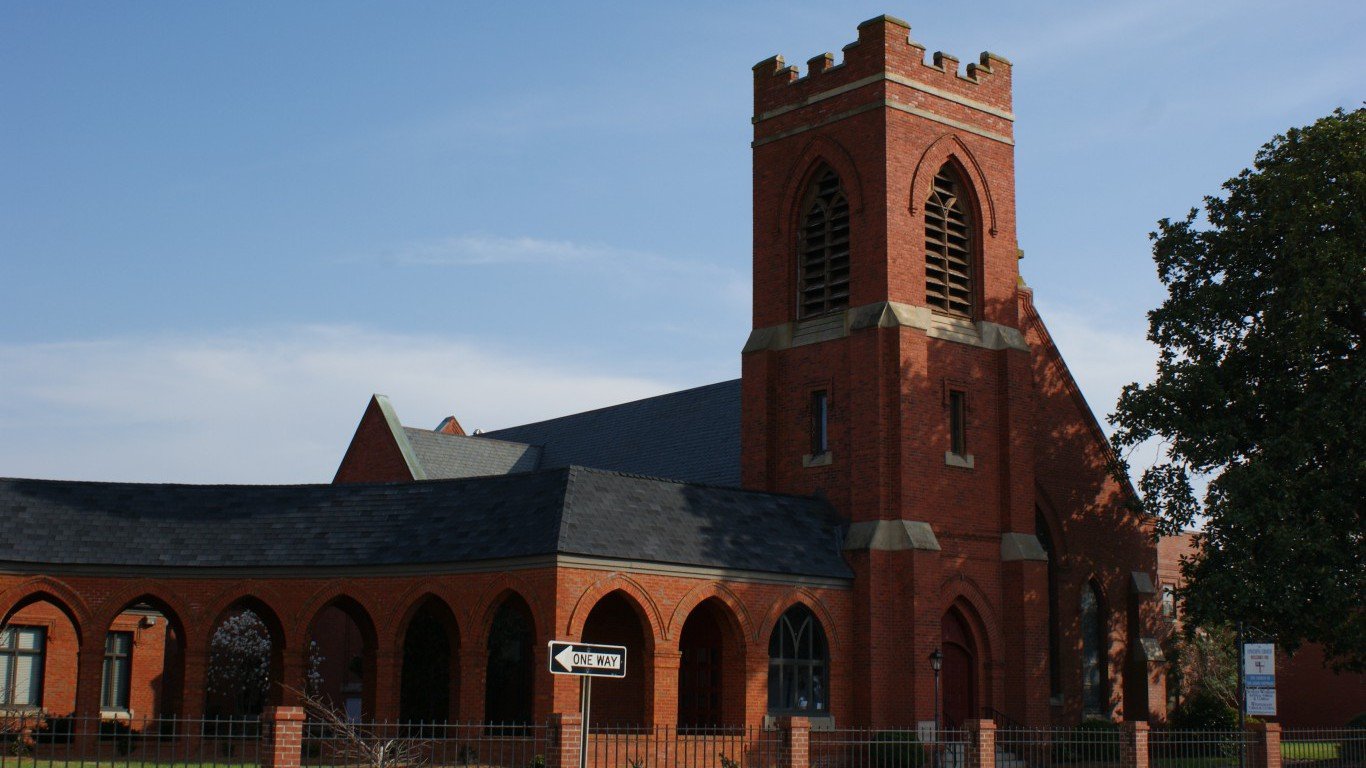
19. Rocky Mount, NC
> Pct. adults drinking to excess: 12.9%
> Pct. driving deaths involving alcohol: 31.3%
> Est. number of restaurants and bars: 206 (139.8 per 100,000)
> Median household income: $38,972
Some 12.9% of adults in Rocky Mount, North Carolina drink excessively, one of the smallest shares of any metro area. While excessive drinking is not especially common in the metro area, other unhealthy behaviors are. About one in every five adults in Rocky Mount smoke, compared to the 17.9% state and 17.0% U.S. smoking rates. Metro area adults are also less likely to exercise than those across the state and nation as a whole.
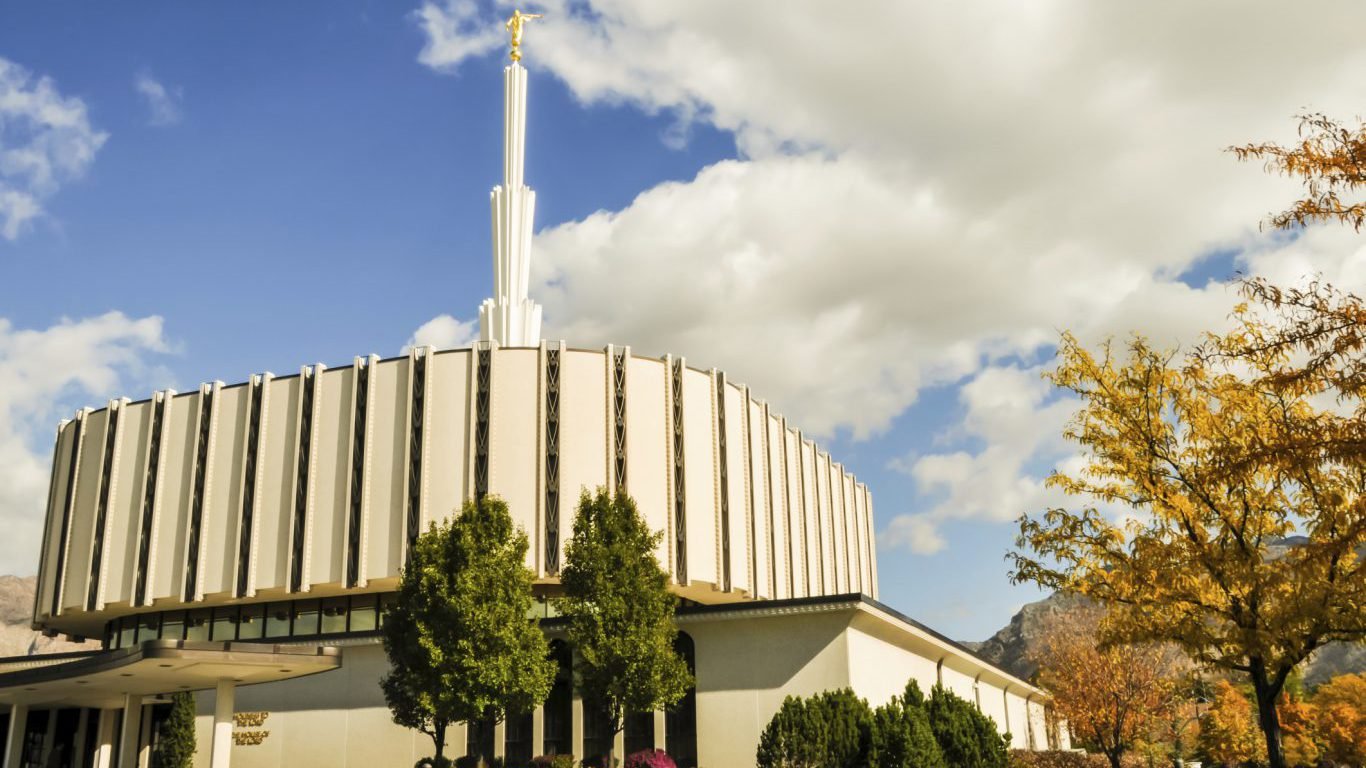
18. Ogden-Clearfield, UT
> Pct. adults drinking to excess: 12.9%
> Pct. driving deaths involving alcohol: 13.9%
> Est. number of restaurants and bars: 836 (127.4 per 100,000)
> Median household income: $70,227
Driving is dangerous and a range of factors and circumstances can lead to deadly mistakes on the road. In Ogden-Clearfield, Utah, drunk driving is rarely the culprit. Just 13.9% of driving deaths in the metro area involved alcohol, which was one of the lowest rates in the country and less than half the nationwide rate of 30.0%.
Alcohol is expensive and most of the cities with the lowest excessive drinking rates are relatively low-income. One of the most affluent metro areas in the country, Ogden-Clearfield, Utah is an exception. The metro area’s $70,227 median household income is about $12,600 higher than the national median. The area’s low excessive drinking rate is likely because the majority of residents in Utah are Mormons, and the Mormon church teaches its members to abstain from alcohol.
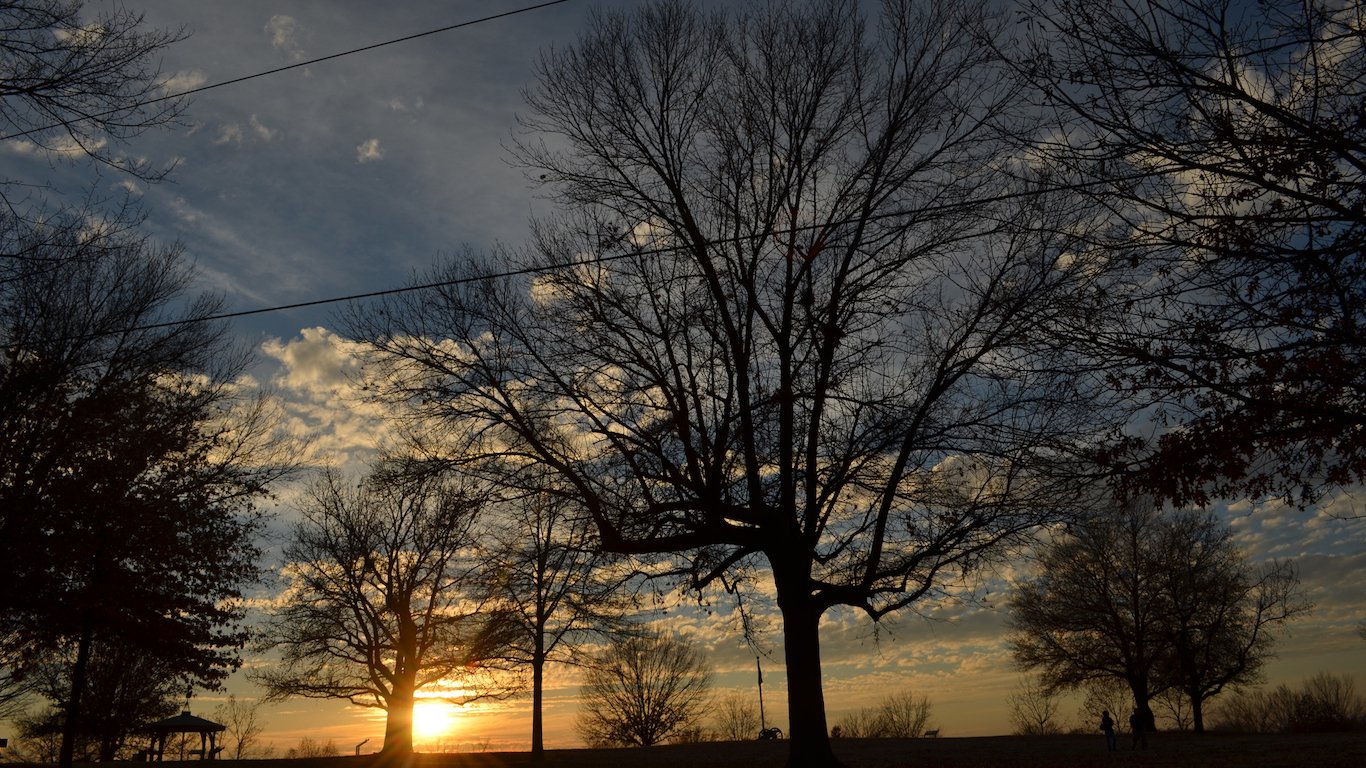
17. Fort Smith, AR-OK
> Pct. adults drinking to excess: 12.9%
> Pct. driving deaths involving alcohol: 31.7%
> Est. number of restaurants and bars: 397 (141.2 per 100,000)
> Median household income: $40,970
Some 12.9% of the adult population in Fort Smith, Arkansas, drinks excessively, the second smallest share of any metro area in the state and one of the smallest shares of any U.S. metro area. In comparison, 18.0% of American adults and 15.9% of adults across Arkansas drink excessively.
Like many metro areas with lower than average excessive drinking rates, Fort Smith is relatively poor. The typical metro area household earns just $40,970 a year, below both the median income across the state of $44,334 a year and the national median of $57,617 a year. Alcohol can be expensive, and many low income households spend their money elsewhere.
[in-text-ad-2]
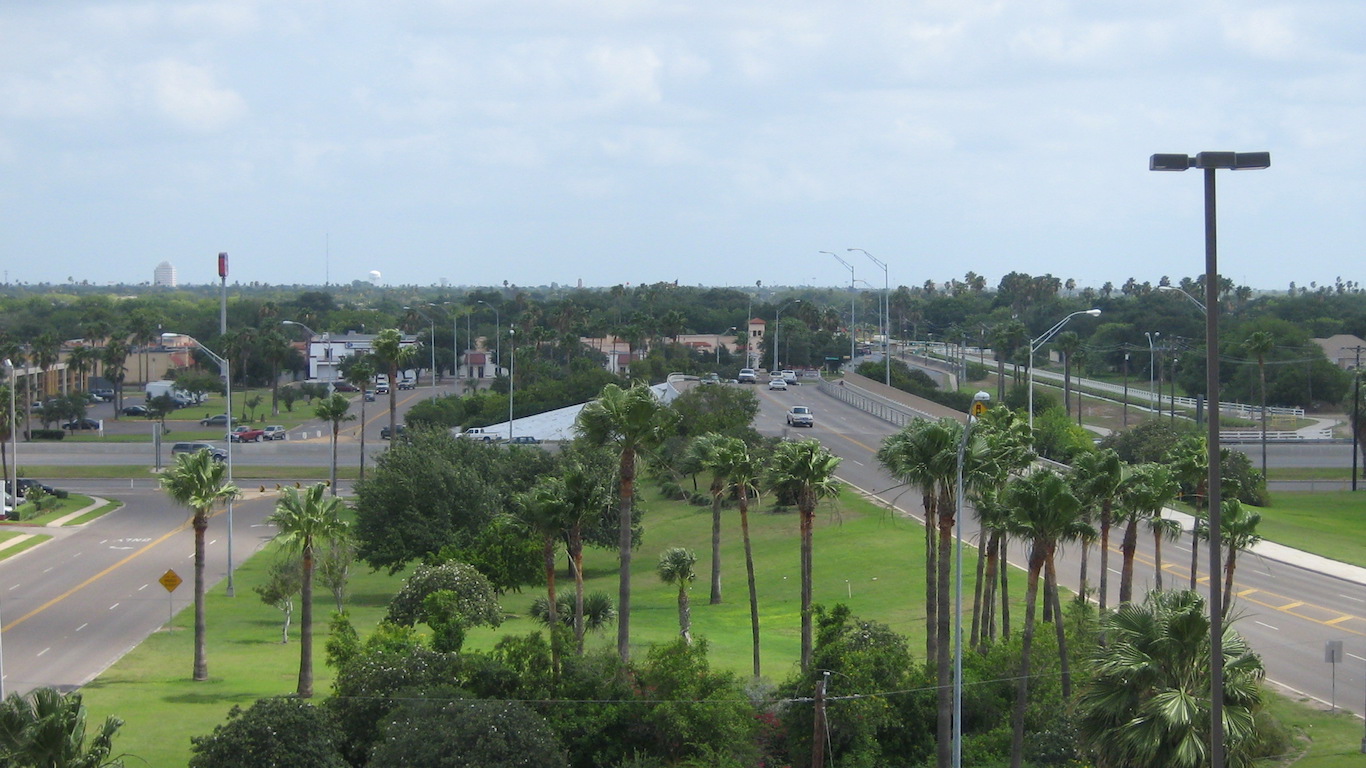
16. McAllen-Edinburg-Mission, TX
> Pct. adults drinking to excess: 12.8%
> Pct. driving deaths involving alcohol: 27.9%
> Est. number of restaurants and bars: 935 (110.0 per 100,000)
> Median household income: $36,176
Of the 25 metro areas in Texas, McAllen-Edinburg-Mission has by far the lowest excessive drinking rate. Some 12.8% of adults in McAllen drink to excess, compared to 19.4% of adults across the state.
The median annual household income in the southern Texas metropolitan area is $36,176, which is more than $20,000 below the national median and the second lowest median income of any U.S. metro area. The relatively small share of residents with disposable income may partially explain why the McAllen area has just 110 bars and restaurants per 100,000 people, one of the lowest concentrations in the country.
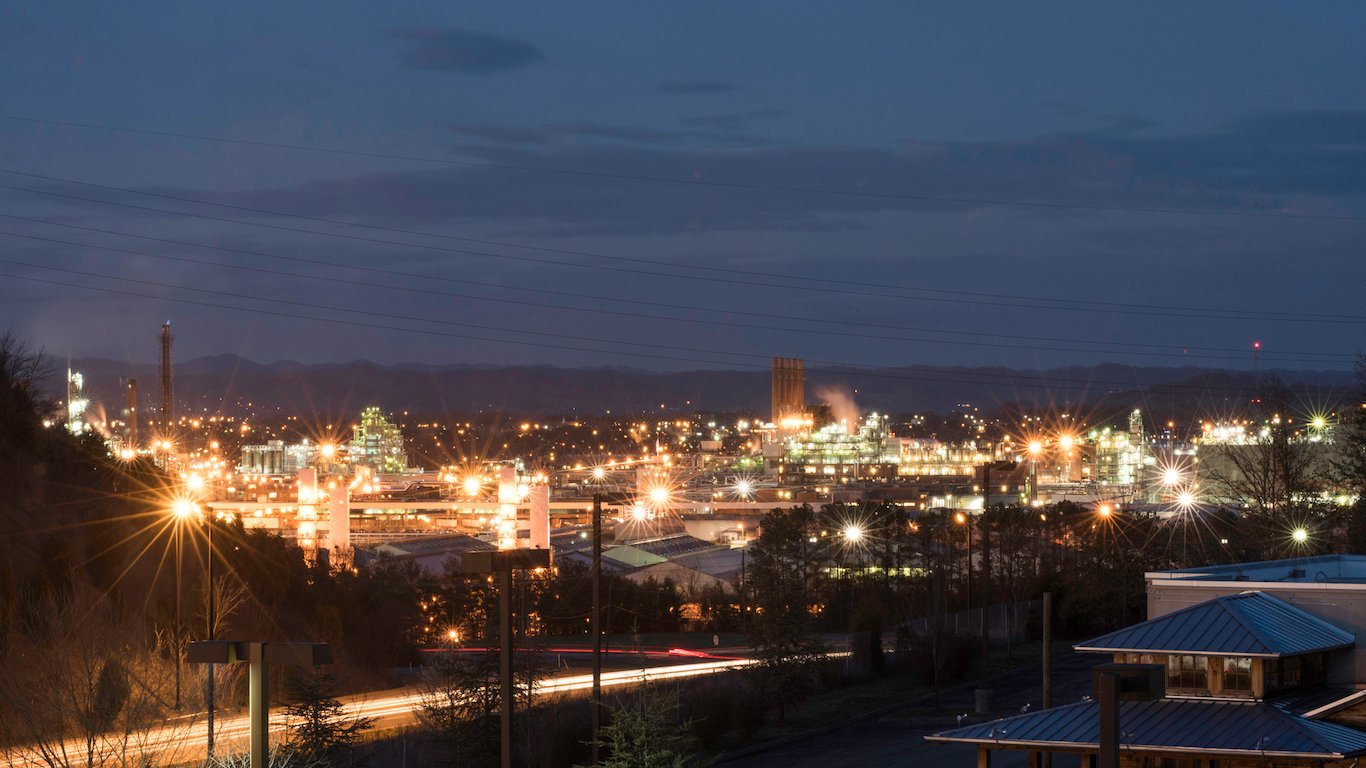
15. Kingsport-Bristol-Bristol, TN-VA
> Pct. adults drinking to excess: 12.7%
> Pct. driving deaths involving alcohol: 19.8%
> Est. number of restaurants and bars: 509 (165.4 per 100,000)
> Median household income: $40,811
A relatively small 12.7% share of adults in the Bristol, Tennessee, metropolitan area drink excessively. Additionally, a relatively small portion of fatal auto accidents in the area are attributed to drunk driving. Of the fatal auto accidents in the metro area, fewer than one in five involved alcohol. This is well below the 30.0% of driving deaths nationwide.
College students age 18 to 22 are more likely than the typical adult to binge drink, increasing the excessive drinking rate in places where many of them live. In the Bristol area, just 4.4% of residents are enrolled in college, below the 7.0% national average.
[in-text-ad]
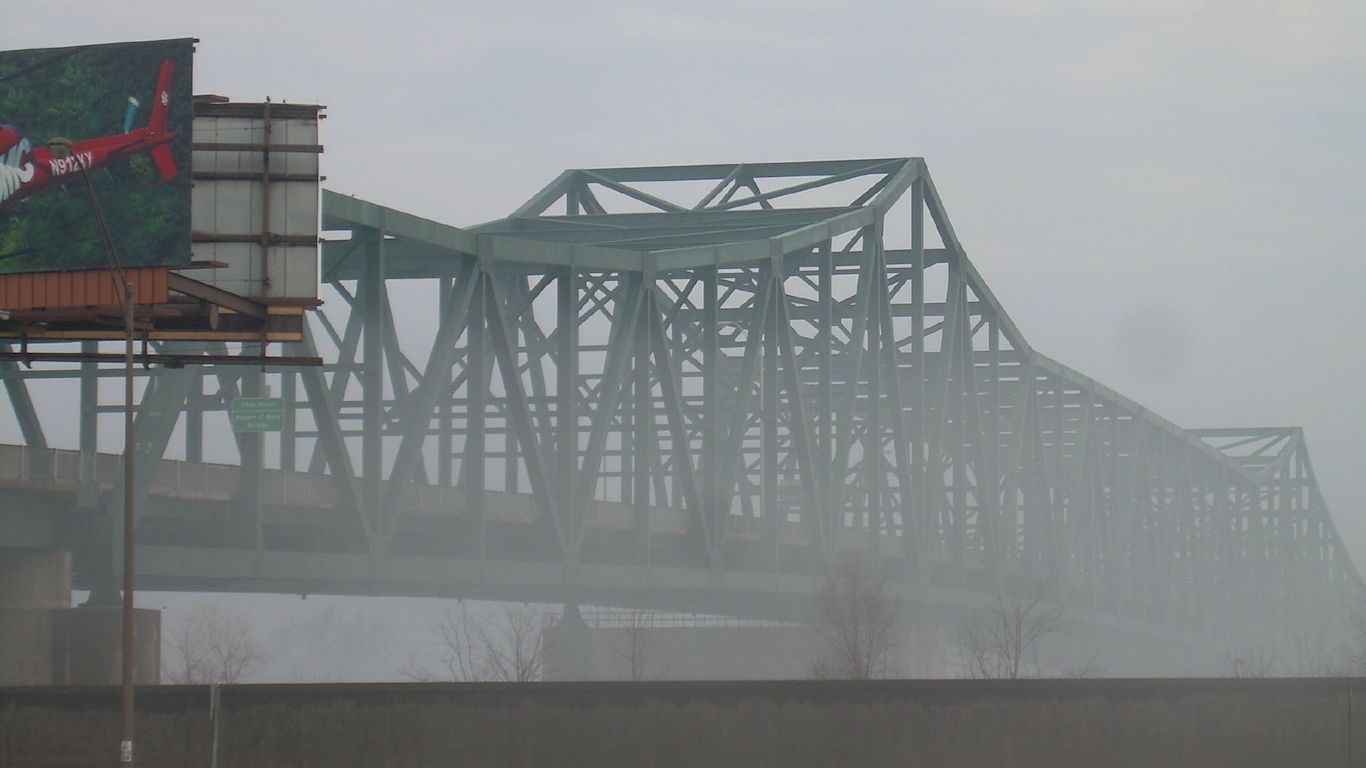
14. Huntington-Ashland, WV-KY-OH
> Pct. adults drinking to excess: 12.6%
> Pct. driving deaths involving alcohol: 26.5%
> Est. number of restaurants and bars: 574 (159.6 per 100,000)
> Median household income: $42,420
Just 11.8% of West Virginia adults drink excessively, a smaller share than in any other state. Though the Huntington metro area has a higher excessive drinking rate than West Virginia as a whole, at 12.6%, it still ranks among U.S. cities with the lowest excessive drinking rates.
Alcohol may be prohibitively expensive for many lower income Americans. In the Huntington metro area, the typical household earns $42,420 a year, well below the national median household income of $57,617 a year.
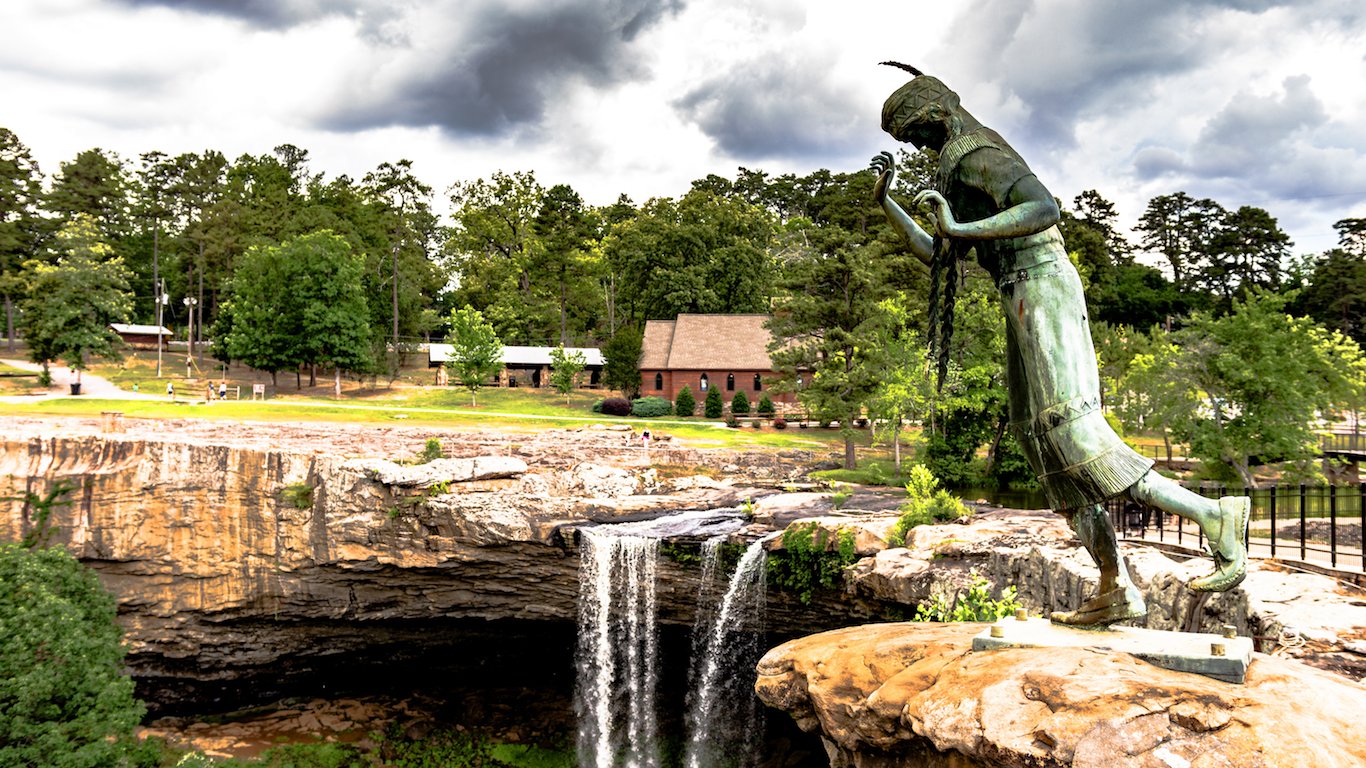
13. Gadsden, AL
> Pct. adults drinking to excess: 12.4%
> Pct. driving deaths involving alcohol: 31.5%
> Est. number of restaurants and bars: 158 (154.1 per 100,000)
> Median household income: $41,152
Some 12.4% of adults in Gadsden report drinking excessively, the lowest rate in Alabama, which already has one of the lowest excessive drinking rates among states at 14.2%. While unhealthy drinking habits are not especially common in Gadsden, other unhealthy habits are. Some 34.2% of adults in the Gadsden area report no leisure time physical activity, one of the highest inactivity rates of any U.S. metro area. Also, 36.8% of metro area adults are obese — one of the highest obesity rates of any U.S. metro area.
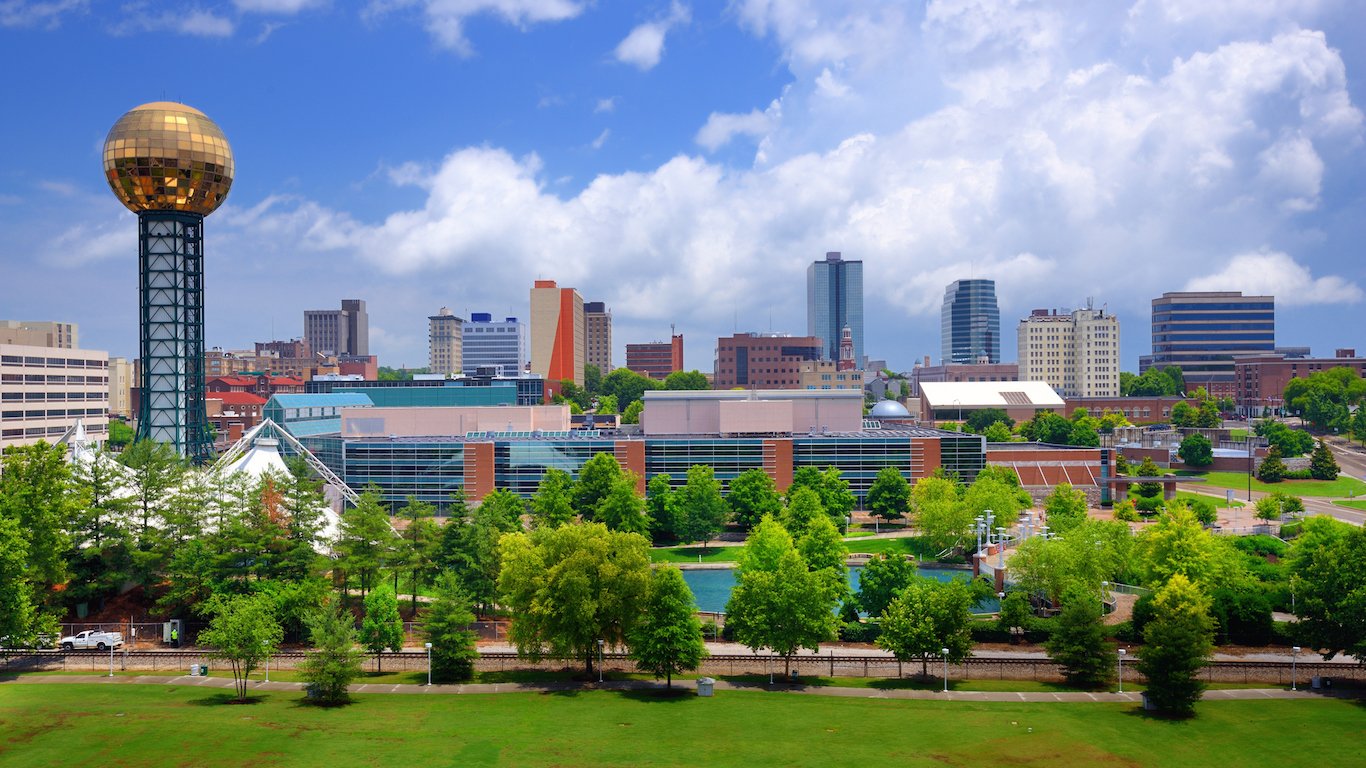
12. Knoxville, TN
> Pct. adults drinking to excess: 12.3%
> Pct. driving deaths involving alcohol: 28.9%
> Est. number of restaurants and bars: 1,353 (155.7 per 100,000)
> Median household income: $49,862
Knoxville is home to the University of Tennessee and its 28,321 students. College towns frequently report higher than average excessive drinking rates, but not Knoxville. Just 12.3% of area adults drink excessively, compared to the 18.0% of American adults who do.
Since the number of students at the school represent a small fraction of the Knoxville area’s 869,076 residents, students at the University of Tennessee do not drastically increase the excessive drinking rate for the area. In fact, only 6.4% of Knoxville area residents are enrolled in either undergraduate classes or graduate school. That is slightly below the national rate of college enrollment of 7.0%.
[in-text-ad-2]
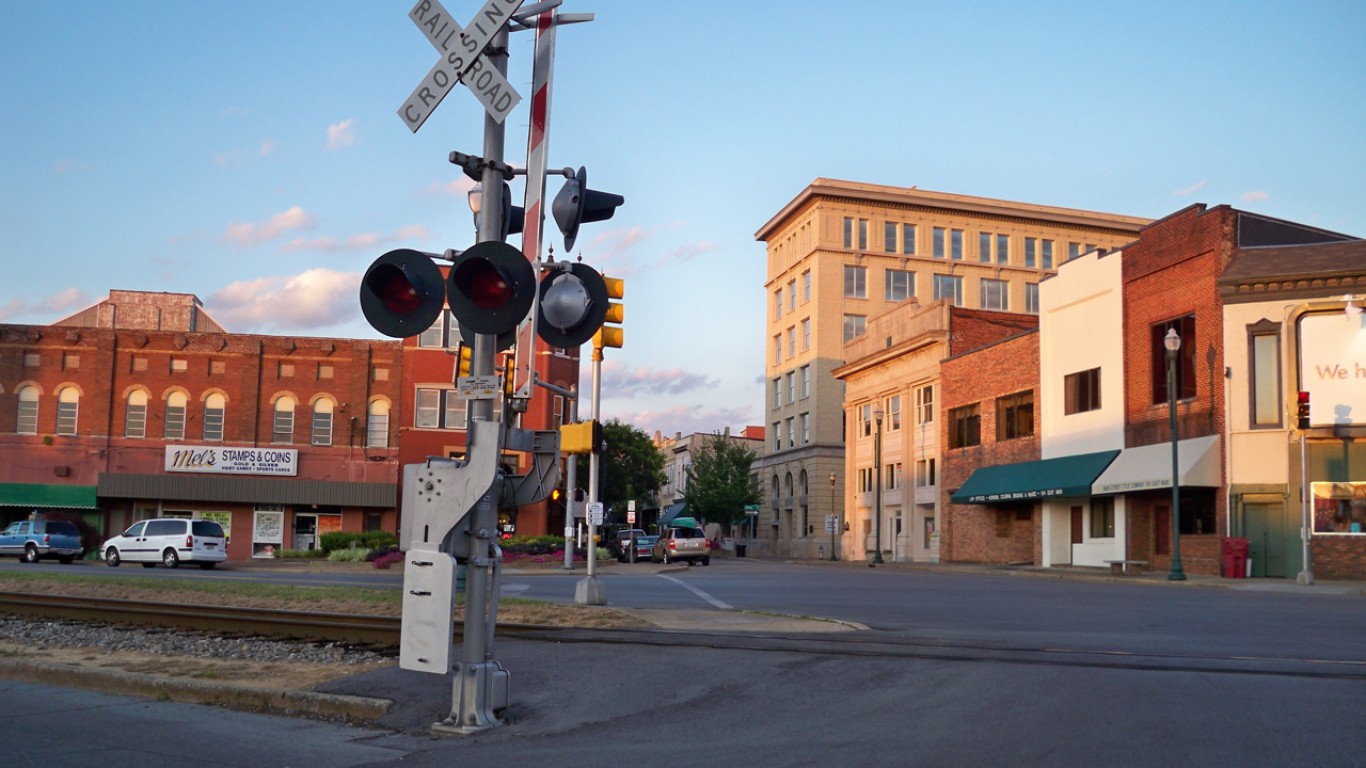
11. Johnson City, TN
> Pct. adults drinking to excess: 12.3%
> Pct. driving deaths involving alcohol: 31.7%
> Est. number of restaurants and bars: 330 (164.6 per 100,000)
> Median household income: $40,943
Just 12.3% of adults in the Johnson, Tennessee, metro area report excessive drinking. . While unhealthy drinking habits are not especially common in Johnson City, other unhealthy habits are.
Some 32.1% of adults report no leisure time physical activity, one of the highest rates of any U.S. metro area. A lack of exercise can increase the risk of serious conditions such as diabetes, high blood pressure, and some types of cancer and adults in Johnson City are less likely to be in good health than the typical American adult.
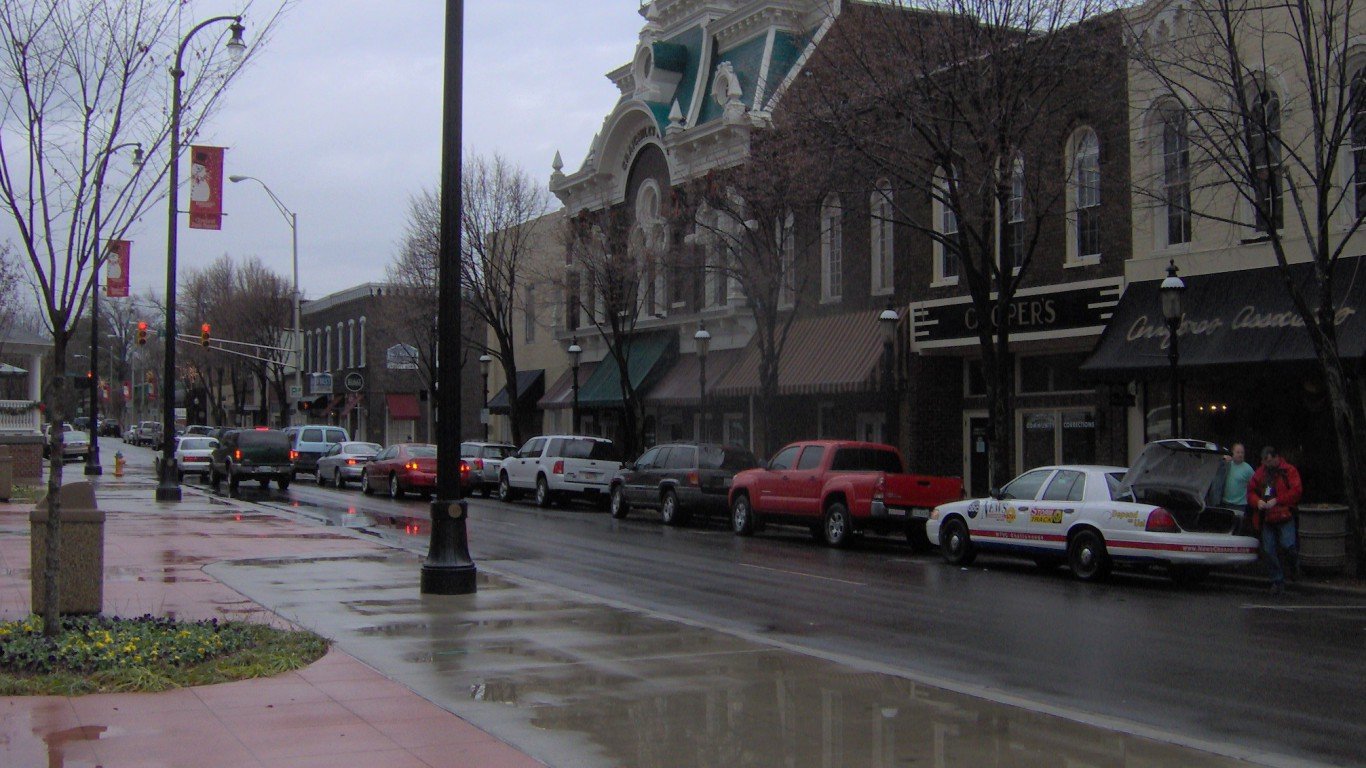
10. Cleveland, TN
> Pct. adults drinking to excess: 12.2%
> Pct. driving deaths involving alcohol: 41.0%
> Est. number of restaurants and bars: 166 (134.0 per 100,000)
> Median household income: $44,881
The Cleveland, Tennessee, metropolitan area is one of several in the Volunteer State among U.S. cities with the lowest excessive drinking rates. Some 12.2% of Cleveland area adults drink excessively, below the statewide excessive drinking rate of 14.4%.
Though relatively few adults in the metropolitan area drink excessively, the area has a high rate of alcohol-related fatal auto accidents. Alcohol played a role in 41.0% of automotive fatalities in the area from 2011 to 2015, compared to 30.0% of driving deaths nationwide during the same time.
[in-text-ad]

9. Pine Bluff, AR
> Pct. adults drinking to excess: 12.2%
> Pct. driving deaths involving alcohol: 34.8%
> Est. number of restaurants and bars: 115 (122.2 per 100,000)
> Median household income: $37,076
Some 12.2% of Pine Bluff, Arkansas, area adults report drinking excessively — the lowest rate of any metro area in Arkansas and below the statewide excessive drinking rate of 15.9%.
Buying alcohol can be expensive, and places with lower incomes frequently have lower rates of unhealthy alcohol consumption. This is the case in Pine Bluff, one of the poorest places in America. The median household income in the metro area of $37,076 a year is more than $20,000 below the national median household income. Only a handful of other U.S. metro areas have a lower median household income. Some 21.8% of Pine Bluff residents live in poverty compared to 14.0% of people nationwide and 17.2% of Arkansas residents.
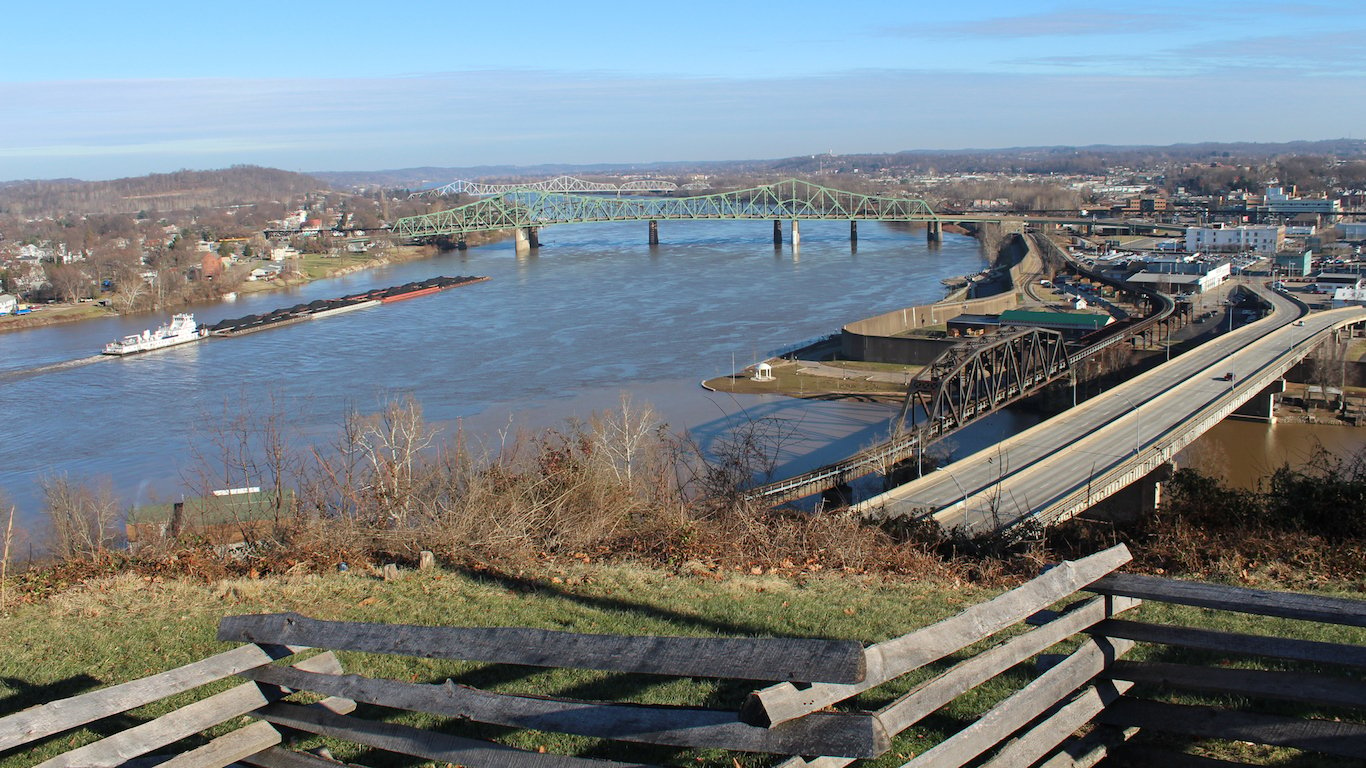
8. Parkersburg-Vienna, WV
> Pct. adults drinking to excess: 12.2%
> Pct. driving deaths involving alcohol: 30.6%
> Est. number of restaurants and bars: 194 (214.2 per 100,000)
> Median household income: $46,594
Much like the rest of West Virginia, very few residents the Parkersburg-Vienna metro area drink excessively. Some 12.2% of area adults report excessive drinking. Though it is the eighth lowest rate among U.S. metro areas, it is above the West Virginia excessive drinking rate of 11.8%, the lowest of all states.
Despite the low excessive drinking rate, there are many places in the Parkersburg-Vienna area to buy alcohol. There are 214 bars and restaurants per 100,000 people for residents to buy alcohol, greater than the national concentration of 184 bars and restaurants per 100,000 people.
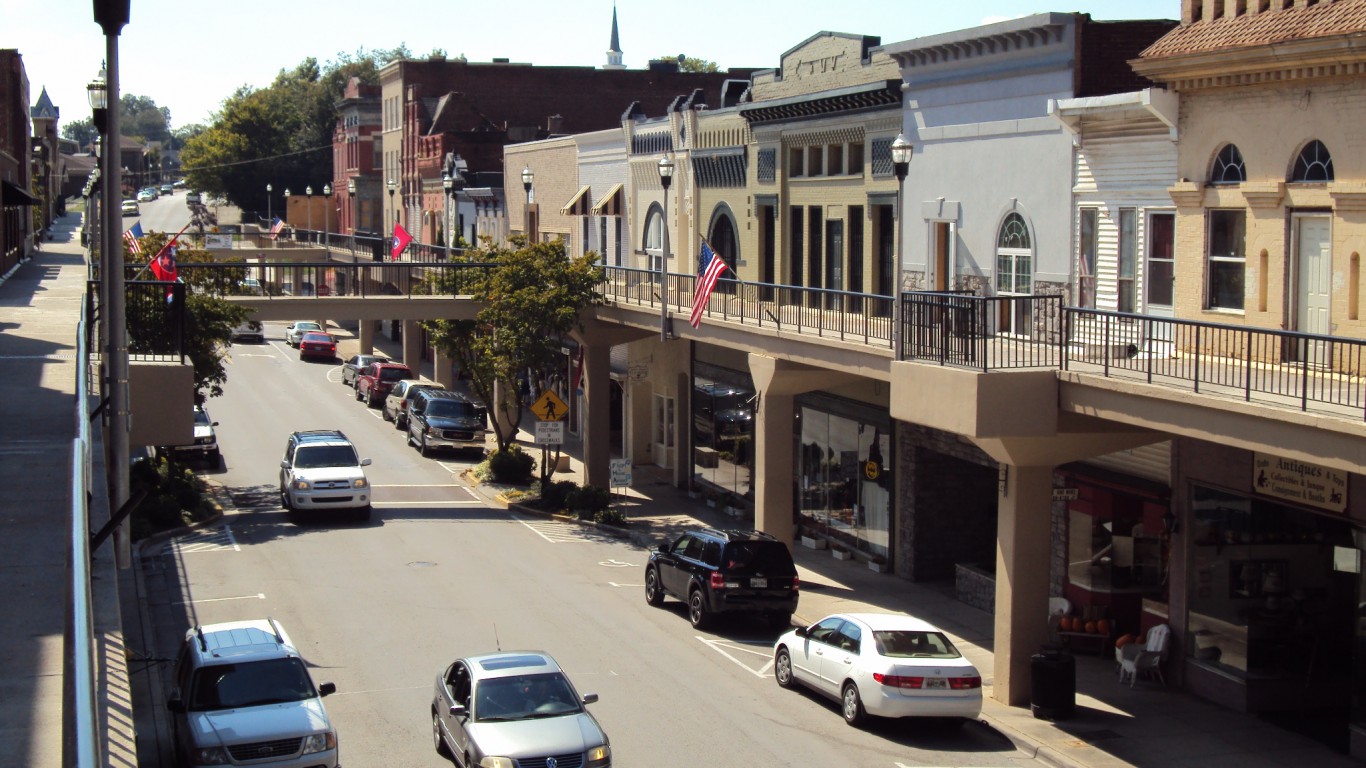
7. Morristown, TN
> Pct. adults drinking to excess: 11.9%
> Pct. driving deaths involving alcohol: 26.4%
> Est. number of restaurants and bars: N/A
> Median household income: $44,348
Some 11.9% of adults in Morristown, Tennessee, drink excessively. The state of Tennessee has some of the more restrictive liquor laws in the country. It is illegal to sell wine in the state on Sundays, and grocery stores only recently gained the ability to sell wine at all.
Those restrictive alcohol sales laws may be one of the reasons why Tennessee’s metro areas are some of the driest in the country. Of the 20 cities with the lowest excessive drinking rates, six are in the Volunteer State.
[in-text-ad-2]

6. Logan, UT-ID
> Pct. adults drinking to excess: 11.6%
> Pct. driving deaths involving alcohol: 16.7%
> Est. number of restaurants and bars: 167 (123.3 per 100,000)
> Median household income: $57,414
Logan, Utah, was founded by a group of Mormon settlers in the mid-1800s. Today, a strong majority of city residents identify as Mormon, a religion that teaches its followers to avoid alcohol consumption. Partially as a result, Logan has one of the lowest excessive drinking rates in the United States. Just 11.6% of adults in the metro area either binge or heavily drink, below the 13.4% statewide excessive drinking rate and the 18.0% nationwide rate.
Residents’ drinking habits are reflected in the number of drinking establishments in the metro area. There are only 123 bars and restaurants for every 100,000 Logan residents, one of the smallest ratios of any U.S. metro area.
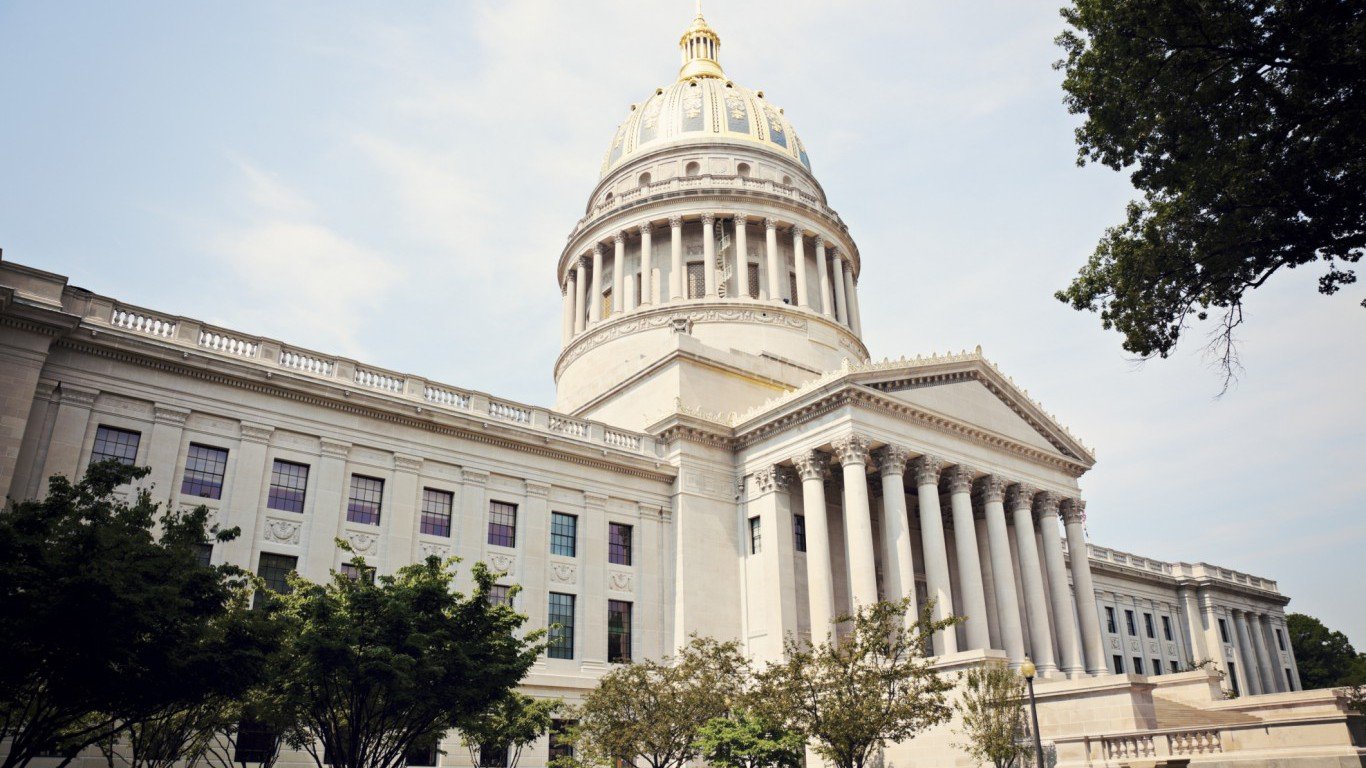
5. Charleston, WV
> Pct. adults drinking to excess: 11.1%
> Pct. driving deaths involving alcohol: 28.7%
> Est. number of restaurants and bars: 405 (184.4 per 100,000)
> Median household income: $41,689
West Virginia’s excessive drinking rate of 11.8% is lower than that of every other state and well below the 18.0% U.S. excessive drinking rate. Charleston is one of four metro areas in West Virginia to rank among the cities with smallest shares of adults who either binge drink or drink heavily. Just 11.1% of adults in Charleston drink excessively, the fifth smallest share of any U.S. metro area and second lowest in the state.
Areas with low excessive drinking rates are often relatively poor, and Charleston is no exception. The typical Charleston household earns just $41,689 a year, below both the statewide median income of $43,385 and the nationwide median of $57,617.
[in-text-ad]
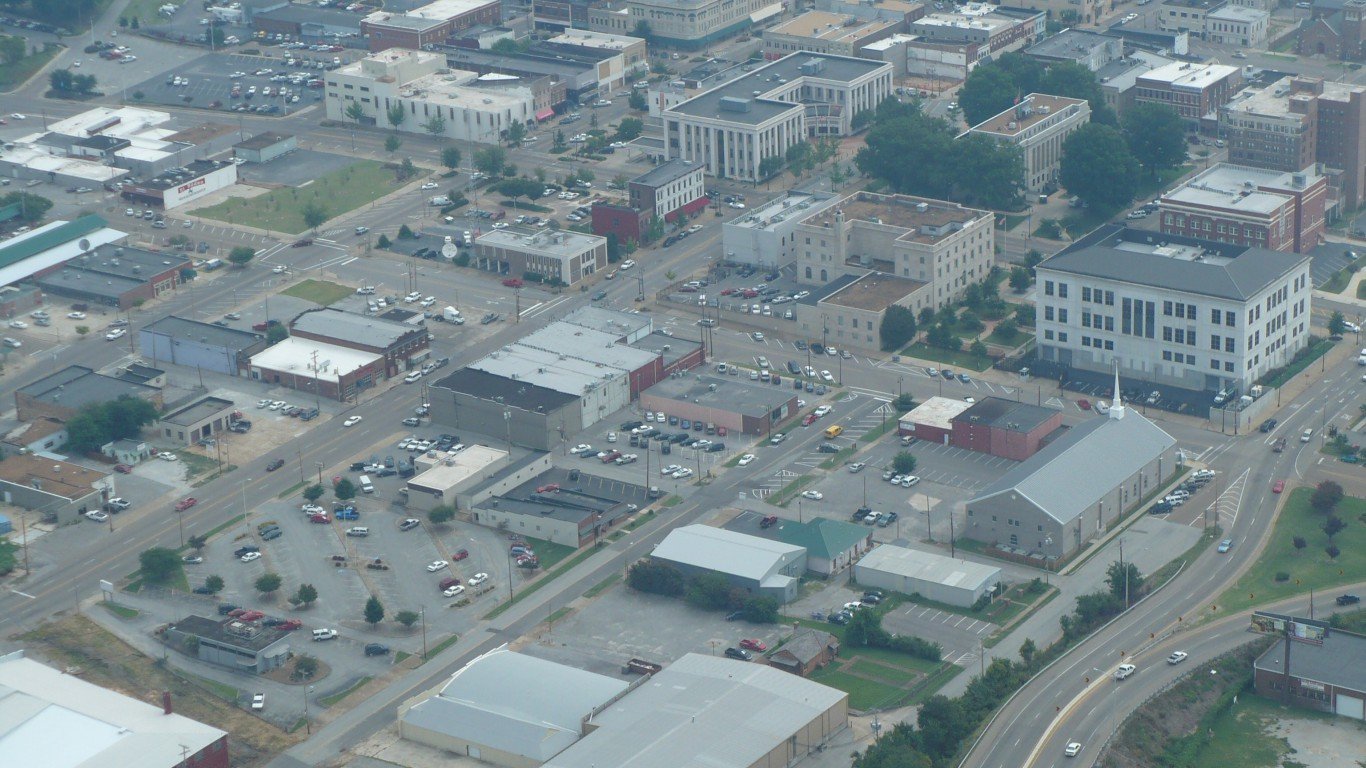
4. Jackson, TN
> Pct. adults drinking to excess: 10.9%
> Pct. driving deaths involving alcohol: 30.7%
> Est. number of restaurants and bars: 217 (167.5 per 100,000)
> Median household income: $42,373
Some 10.9% of adults in Jackson, Tennessee, drink excessively, well below the statewide excessive drinking rate of 14.4% and the nationwide rate of 18.0%. Drinking is income dependent as people with lower incomes may avoid spending money on alcohol. The Jackson area’s median household income of $42,373 is more than $15,000 below the national median and $6,000 under the state median.
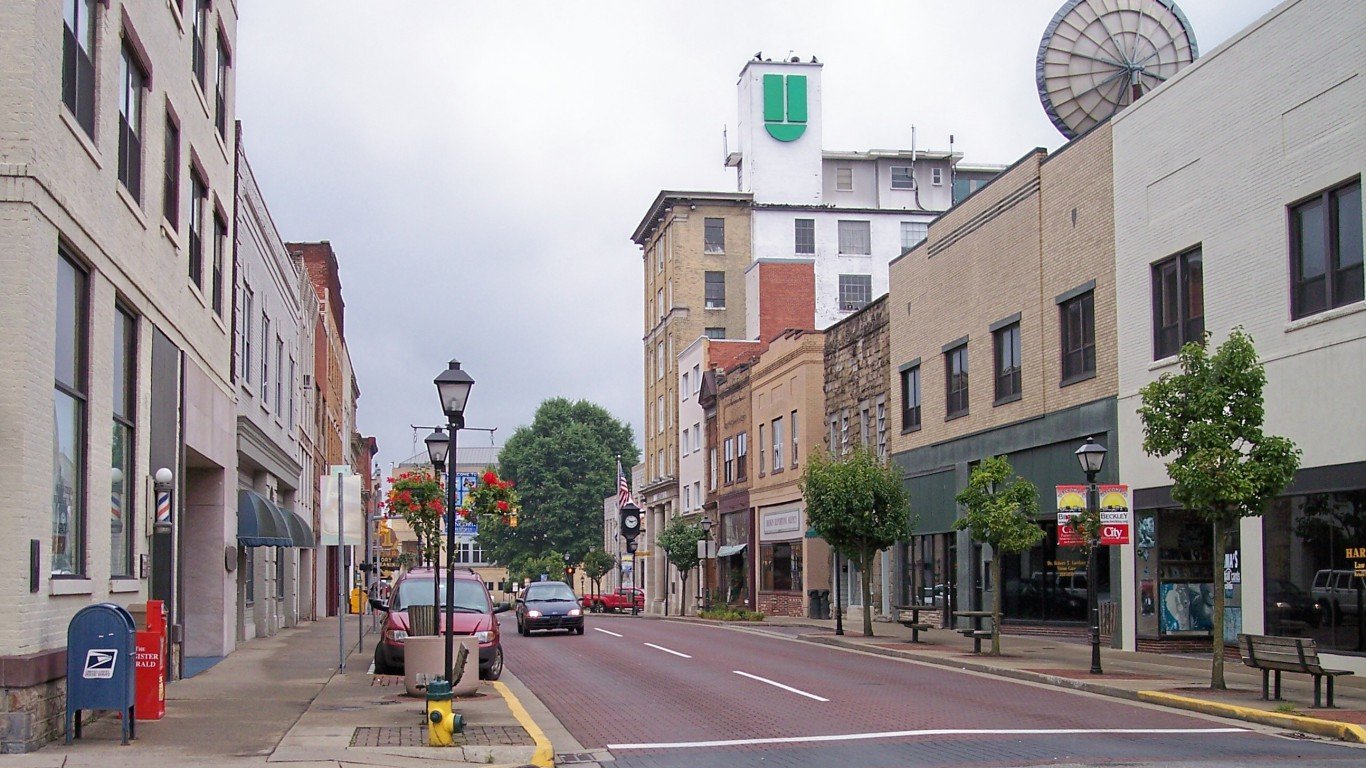
3. Beckley, WV
> Pct. adults drinking to excess: 10.8%
> Pct. driving deaths involving alcohol: 27.9%
> Est. number of restaurants and bars: 179 (148.0 per 100,000)
> Median household income: $44,178
In the Beckley, West Virginia metro area, just 10.8% of adults drink excessively. This percentage is well below the 18.0% of adults nationwide who reported either binge drinking or heavily drinking. The Beckley area also falls a full percentage point below West Virginia’s state excessive drinking rate of 11.8%.
Even though very few Beckley, West Virginia, adults drink excessively, many area residents report other vices.. Some 24.3% of the metro area’s adults smoke tobacco, the highest smoking rate of any metro area in the country.
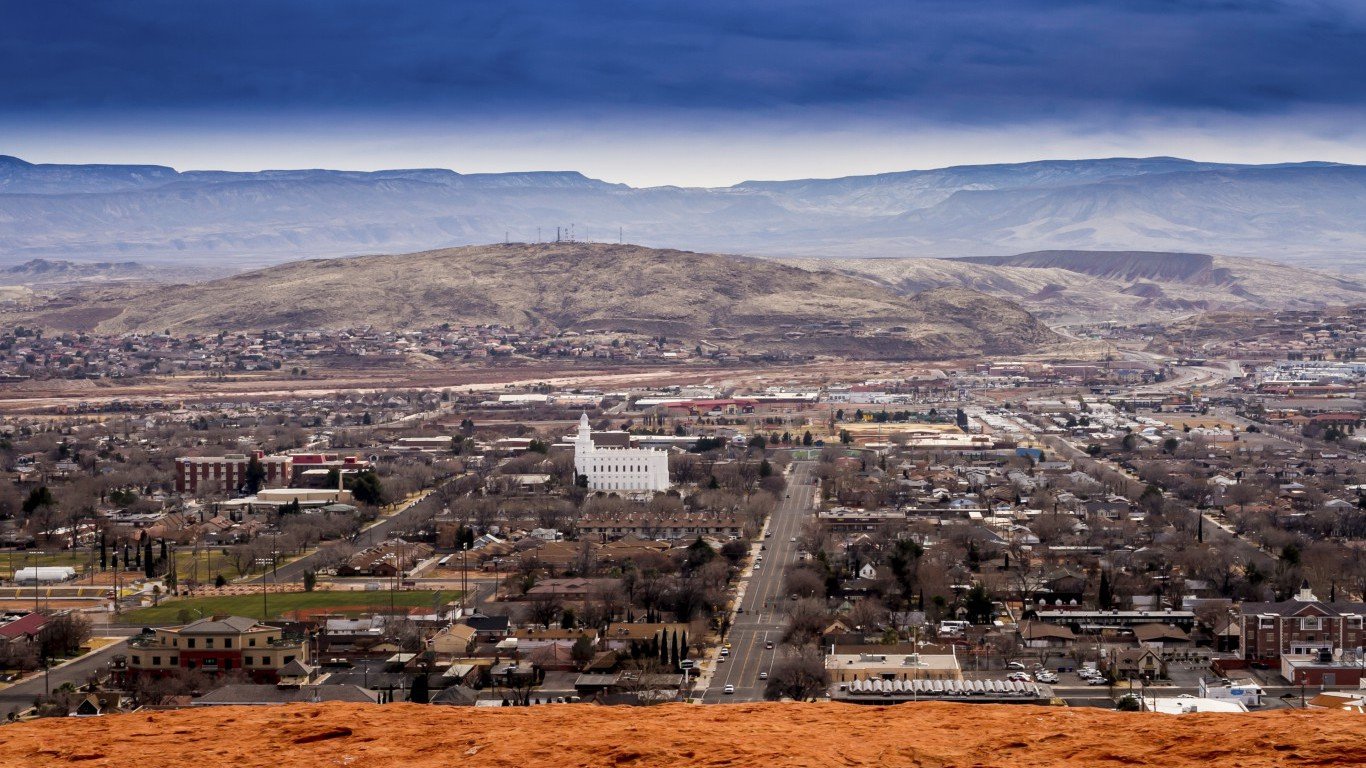
2. St. George, UT
> Pct. adults drinking to excess: 10.8%
> Pct. driving deaths involving alcohol: 15.9%
> Est. number of restaurants and bars: 258 (161.0 per 100,000)
> Median household income: $55,056
Some 10.8% of adults in St. George drink excessively, the second lowest rate in the country. Metro area residents abstain from other unhealthy vices as well. Just 7.7% of St. George area adults smoke, the second lowest smoking rate in the nation and less than half the national smoking rate of 17.0%.
As is the case in much of Utah, abstention from unhealthy behavior is closely tied to residents’ religious beliefs. The majority of Utah residents are Mormon, a religion that discourages consumption of alcohol and tobacco.
[in-text-ad-2]

1. Provo-Orem, UT
> Pct. adults drinking to excess: 8.5%
> Pct. driving deaths involving alcohol: 14.3%
> Est. number of restaurants and bars: 712 (118.2 per 100,000)
> Median household income: $69,288
Provo-Orem, Utah, is by far the driest metro area in the United States. Just 8.5% of area adults report drinking excessively, well below anywhere else in the country and nearly half the nationwide excessive drinking rate of 18.0%. Provo is the home of Brigham Young University. Towns with large colleges will often have high drinking rates because college students tend to drink excessively. However, BYU’s honor code prohibits students from drinking alcohol because of its close association with the Mormon church.
That relationship with Mormonism extends to the rest of the community as well. As of 2017, Utah County, which contains the Provo area, was 84.7% Mormon. The religious group encourages followers to abstain from drinking.
Detailed findings & methodology:
Across broad populations, excessive alcohol consumption rates appear associated with some economic factors. Alcohol is expensive, and an individual’s ability to drink to excess can be limited by their income. Partially as a result, the cities with the lowest excessive drinking rates tend to have lower incomes, and vice-versa.
Of the 20 metro areas with the lowest excessive drinking rates, 18 have a lower median household income than the national annual median of $57,617. Meanwhile, median household incomes in 11 of the metro areas with the highest excessive drinking rates exceed the national median.
Social factors also play a role. In Wisconsin, alcohol consumption is, for many, an integral part of the state’s culture. Half of the heaviest drinking cities are in Wisconsin. On the other end of the spectrum, large segments of the population in Utah are teetotalers. Over 60% of the state’s population identify as Mormon, a religion that teaches its followers to avoid alcohol consumption. Four of Utah’s five metro areas rank among the cities with the lowest excessive drinking rates.
While the health risks associated with excessive alcohol consumption are well established, a large share of excessive drinkers often does not translate to poor health outcomes across a population. Alcohol consumption is just one of a multitude of factors that can affect personal well-being. In fact, because cities with higher excessive drinking rates also tend to have higher incomes, residents can afford healthier diets and lifestyles than lower-income residents in many cities with low excessive drinking rates.
Partially as a result, just one of the 20 cities with the highest excessive drinking rates is home to a larger share of adults in fair or poor health than the 16.0% national average. Meanwhile, 16 of the 20 cities with the lowest excessive drinking rates are home to a larger than typical share of adults in sub-optimal health.
Similarly, fatal car accidents that involve alcohol are not necessarily more common in the cities with the highest excessive drinking rates. Nationwide, 30% of all driving deaths involve alcohol. In eight of the cities with the lowest excessive drinking rates and in 11 of the cities with the highest excessive drinking rates, the share is higher than the nationwide rate.
Business patterns in the cities on both sides of this list also reflect residents’ drinking habits. Nationwide, there are 184 bars and restaurants for every 100,000 people. The concentration of such drinking establishments is higher in all but four of the cities with the highest excessive drinking rates. Meanwhile, only two of the cities with the lowest excessive drinking rates have a higher than average concentration of bars and restaurants.
To identify the U.S. metro areas with the highest and lowest excessive drinking rates, 24/7 Wall St. reviewed the percentage of adults 18 and older who report binge or heavy drinking within a 30 day period across 381 metro areas. Metro-level data was aggregated from county-level data provided by County Health Rankings & Roadmaps, a Robert Wood Johnson Foundation and University of Wisconsin Population Health Institute joint program. All excessive drinking data is as of 2016. Median household incomes, poverty rates, and share of the population in college or graduate school came from the U.S. Census Bureau’s 2016 American Community Survey. The number of bars and restaurants per 100,000 people is also as of 2016 and comes from County Business Patterns, a program maintained by the Census. Health outcomes and factors, including the percentage of adults who report being in fair or poor health and the share of driving deaths that involved alcohol were also aggregated from county-level data obtained from County Health Rankings & Roadmaps and are for the most recent years available.
Ever wanted an extra set of eyes on an investment you’re considering? Now you can speak with up to 3 financial experts in your area for FREE. By simply
clicking here you can begin to match with financial professionals who can help guide you through the financial decisions you’re making. And the best part? The first conversation with them is free.
Click here to match with up to 3 financial pros who would be excited to help you make financial decisions.
Thank you for reading! Have some feedback for us?
Contact the 24/7 Wall St. editorial team.